The RSPB Magazine
Taking action for nature together
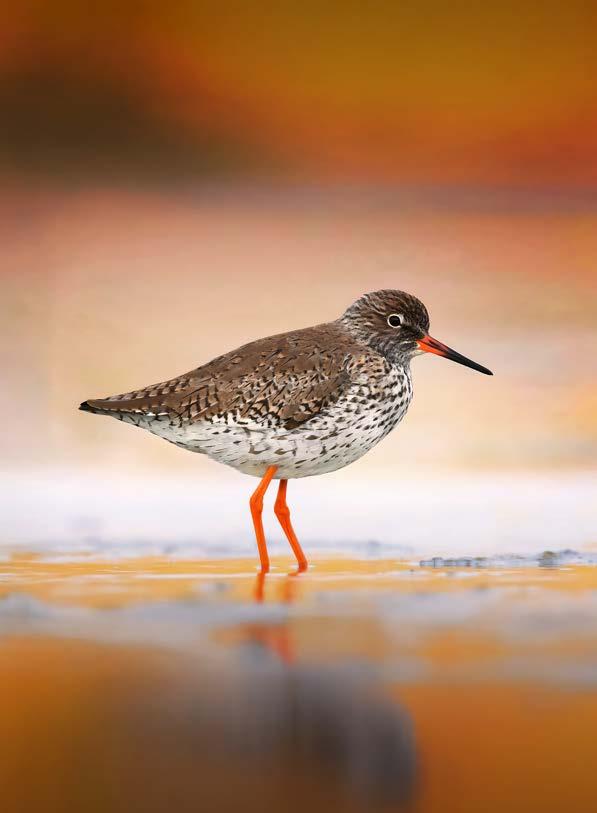

Taking action for nature together

Thanks to you, Redshanks could face a brighter future despite recent declines
Saving our isles
Soar over to see how your support helps
RSPB local groups are a powerful force for nature
Four RSPB places to see the seasons change

The RSPB
Head of Supporter Communications
Sara Farrow
Supporter Communications Manager and Editor
Jamie Wyver
Our Media
Editor Emma Pocklington
Senior Creative Richard Jenkins
Art Editors Emma Jones, Robin Coomber, Kit Cheung, Nicole Mooney
Production Editor Emily Freer
Head of Client Services Ellen Wade
Account Manager Jessica Pratten
Advertising Di Marsh
Thank you to our advertisers for helping cover the costs of this magazine, saving more money for nature. To advertise, email Di.Marsh@ourmedia.co.uk
Magazine
RSPBmagazine@rspb.org.uk (photos max 3MB each, no watermarks)
The RSPB Magazine, The Lodge, Sandy, Bedfordshire SG19 2DL
Membership enquiries 01767 693680 membership@rspb.org.uk
Wildlife enquiries 01767 693690 wildlife@rspb.org.uk
Advertisements in The RSPB Magazine are accepted on the understanding that they conform to the British Code of Advertising Practice. Adverts are not endorsed by the RSPB, unless otherwise stated.
The RSPB Magazine is available on CD for visually impaired members. Call 01767 693680 for information.
Views expressed by contributors are not necessarily those of the RSPB. While every effort is taken to ensure accuracy, we cannot accept liability for errors or omissions.
Circulation 560,824 Jan–Dec 2024 (ABC); The RSPB has 1,154,485 members.
Registered charity in England & Wales 207076, in Scotland SC037654. Member of BirdLife International.
Designed, edited and published by Our Media Limited. Printed by William Gibbons.
Our Media Company is working to ensure that all of its paper comes from well-managed, FSC®-certified forests and other controlled sources. This magazine is printed on Forest Stewardship Council® (FSC®) certified paper. This magazine can be recycled, for use in newspapers and packaging.
In this issue you might notice connections between different areas of the RSPB’s wildlife conservation work. For example, we’re addressing the climate crisis in several ways. We advise the renewable energy sector, proving that harnessing solar or wind power can benefit nature (see p29). We’re also helping by restoring and protecting wetlands such as Forsinard Flows (p42) and coastal saltmarshes. These capture carbon as well as providing habitat for wildlife such as Redshanks (p18).
In tropical rainforests Hutan Harapan (p42) and Gola (p36), carbon is stored and more exotic wildlife thrives because we support sustainable forest use, such as the production of cocoa beans for Gola chocolate. Back in the UK, food production also happens alongside wildlife habitats at RSPB Hope Farm, which turns 25 this year (p25). Data gathered here helps us advise other land managers and campaign for funding for nature-friendly farming (p41). Even the islands where we’re restoring wildlife populations (p70) are connected. Whether we’re working in a seabird colony off the UK coast or replacing lost forest on a remote island in the South Atlantic, the skills, knowledge and mindset of our dedicated teams are closely related. Their ‘can-do’ attitude is also present in the RSPB’s incredible local groups (p34) working tirelessly to bring nature back to urban areas.
And there’s another vital connection: you. Thanks to the support you give the RSPB, we’re involved with all of these special places and projects, saving birds and other wildlife. We hope you enjoy reading about what we’re achieving together.

Jamie Wyver Editor
Protecting habitats, saving species and helping to end the nature and climate emergency.
Super Light. Super steady.

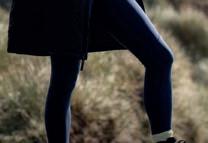
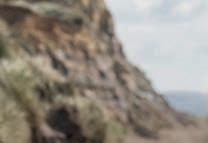








































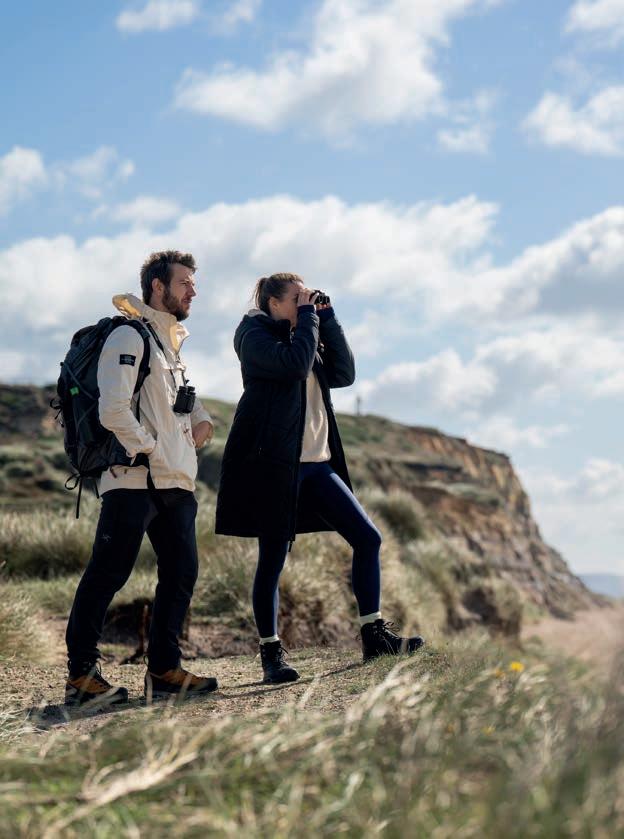
Beccy Speight

Beccy Speight has been the RSPB’s Chief executive since 2019 and has led the organisation through some of nature’s most urgent challenges.
@beccyRSPB




I recently spent an uplifting day at the RSPB’s Hope Farm in Cambridgeshire. I was there to celebrate its 25th anniversary with RSPB staff, industry representatives and members of the press and, between reminiscing and talks, we all got to see what a special place it has become. Read more about our day on page 25.
Over a quarter of a century, it has become an inspiring example of what, I believe, makes the RSPB unique: an organisation with a breadth of focus and expertise unlike any other.
Species, places, policy, people and science – we uniquely encompass them all. This gives the RSPB huge credibility and a depth of understanding of the issues at stake. More importantly, it gives us real insight into how to fix them.
At Hope Farm we do the research, put the policy into practice, and bring others along on our journey. During this latest visit, I was joined by senior staff from the National Farmers’ Union, who were keen to share in what we have achieved and how it might be applied to other farms elsewhere.
Our evidence base means that we can be confident in the decisions that we make. It also means that we are not afraid to make tough choices or do difficult things.
And far from being random or scattered, all this work is connected – informing other projects and ensuring we deliver for nature as a whole. Take our work on island restoration and biosecurity, for example (p70). The places we work and the projects we undertake are
‘Together we can – and must – continue to do amazing things for nature. The future depends on it’
sometimes at the very limit of what is possible, and that means we sometimes don’t succeed. But we learn a great deal from every attempt, making future projects more likely to succeed.
Where and how to site renewable infrastructure is another good example. We desperately need more renewable energy; climate change is one of the biggest drivers of nature loss. However, how to achieve this without negatively impacting nature is a critical question. Recent work from the RSPB’s conservation science team has shown that, with the right management, solar farms can benefit Red-listed farmland birds and help maintain connectivity within populations, providing them with a lifeline (p29).
To undertake this breadth of work requires funding, and you will see our accounts for the past financial year within this issue (p46). We had a record year for income, thanks to all those who support us, but we also had record costs. It’s not just the cost of doing business that has increased; we are also doing more as we address the scale of the challenge to the natural world.
As an organisation, we must be both sure-footed and nimble. The income we receive from grants, foundations and partnerships enables us to commit to projects that last for years, just as we have done at Hope Farm. That commitment to particular species or places means that time and time again we have a long and lasting impact.
But it is you, our members, who allow us also to remain nimble, able to react to quickly changing circumstances and put nature’s best interests first when needed most.
Together with us, you create a powerful movement for nature. This is vital in shifting both public opinion and decision-makers’ choices. Anyone who attended the Restore Nature Now march in London last year will have seen what a powerful force that collective energy can be. Together we can – and must – continue to do amazing things for nature. The future depends on it.


All RSPB work is connected to help save nature, learn more in this issue
18
Saving Redshanks
Habitat protection helps Redshanks
Forsinard is 30
This season
10 Days out in nature: winter is still a great time to get outside
11 Nature notes: Nicola Chester on the many wonders of the season
12 How to: draw from your photos in our brand-new section
14 ID challenge: learn to identify winter ducks
15 Species focus: Winter Moths
16 Designed by nature: how long do birds live?
Comment
05 Beccy Speight: what makes the RSPB unique, plus next steps
25 Simon Barnes: celebrating 25 years of Hope Farm
Helping reduce carbon with renewables work and land management
Protecting seabird colonies and rare island species
Protecting seas by striving for nature-friendly offshore wind
Helping farmers in the UK and abroad
Nature-friendly farming practices at Hope Farm can be applied to land around solar farms
78 David Lindo: Black History Month
Action for nature
36 Places: Gola Rainforest National Park earns World Heritage status
38 People: mass lobby gathers for nature
41 Science: new study could benefit Corn Buntings in Scotland
Features
Renewable energy
18 Wildlife: seen as an every-wader, the Redshank is in decline. This early warning is shining a spotlight on saltmarshes
29 Bigger picture: renewable energy is vital for our future and, done right, it can help nature too
34 Local groups: these community groups are a huge driving force saving many species
48 Our places: uncover four RSPB nature reserves to enjoy
70 Our work: the RSPB is protecting islands across the globe
82 Takeouts: three things to think about and do from this issue
Together for nature
57 Your stories: meet Jack, a fundraising superstar
58 Your say: your letters and stories
60 Your photos: share your pictures
62 Your gardens: a visit to the RSPB and RHS Swift Garden
66 Your questions: The RSPB answers your wildlife queries
Also in this issue
59 Crossword: you asked and we delivered. Try your hand at our brand-new crossword and let us know what you think
On the cover

On page 18, read about the people and projects working to reverse the Redshank’s fortunes.
Enjoy all these articles plus videos from our experts, sound clips of bird calls and wildlife quizzes when you switch to digital membership. Scan for more info


The light crescent on this Ring Ouzel’s breast distinguishes it from the similar, but slightly larger, Blackbird. In autumn, this moorland thrush will be on the move. Ring Ouzels that bred or fledged here, or further afield, pass through the UK on their journeys south, then spend the colder months in southern Spain or North Africa. The Ring Ouzel’s population decline in the UK may be caused by loss of good-quality habitat and climate change affecting availability of food sources. The RSPB has worked on Ring Ouzel research at RSPB Dove Stone and Geltsdale, as well as Glen Cunie in Aberdeenshire, to discover the best ways to manage land to benefit these birds.
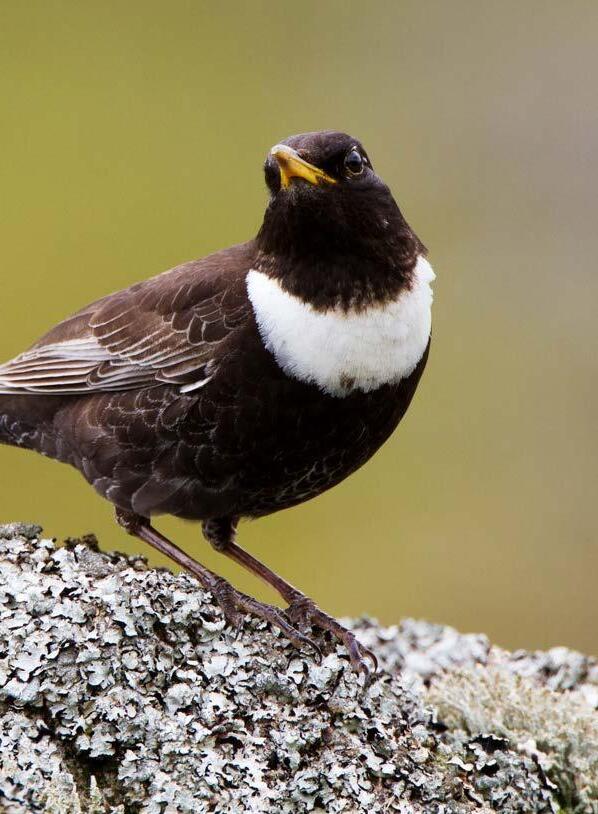

There are plenty of reasons to get outside in autumn and winter
1. Go forest bathing
RSPB The Lodge
Step into The Lodge’s tranquil forests and enjoy a moment of calm on a guided, meditative walk designed to help you unwind and connect with nature. Running on 1 November and 6 December, 1pm–3pm, £40.50 (£45 non-members) book via events.rspb.org.uk/forestbathing Learn more about The Lodge on page 50.
2. Watch Badger banquets
RSPB Mersehead
Feast your eyes on badgers as they snuffle around for a snack in the garden. Watch them close up from the comfort of the Sulwath Centre on 11, 16, 21 and 31 October, and who knows what else might turn up? Booking is essential and spaces are limited. See more at events.rspb.org. uk/mersehead
3. Red Squirrel watch
RSPB Loch Leven
Enjoy a magical start to the day with a sunset trail walk looking for Red Squirrels. Join on 18 or 21 October to learn more about these much-loved, bushy-tailed animals, and enjoy the stunning views of the loch afterwards. events.rspb.org.uk/ events/127442
4. Get a guided tour
RSPB Ynys-hir
Indulge in an extraordinary journey across Celtic rainforest and saltmarshes with your own personal guide at RSPB Ynys-hir and see what wildlife you can discover. Whether you’re a nature expert or a curious novice, the tour will be tailored to suit your needs. Guide hire costs £50 for four for two hours (£80 nonmembers). Email ynyshir@rspb.org.uk
5. Make festive wreaths
RSPB South Stack
Get in the spirit of the season and enjoy guided wreath making and an afternoon tea, all with the backdrop of South Stack’s spectacular sea view. Join from 2pm–4pm on 30 November to make a beautiful festive decoration to take home. £50 per person, book via events.rspb.org.uk/ southstackcliffs See p49 to discover more about this nature reserve.
6. Experience the goose roost
RSPB Loch Leven
Enjoy the incredible annual spectacle of thousands of Pink-footed Geese (pictured) taking off from the loch at dawn, while learning fascinating facts about the geese from the on-site Warden. These geese roost on site, and then take off each morning to the backdrop of sunrise. Join on 22 and 25 October, £13 (£16 non-member), visit rspb.org.uk/ dawn-goose-watch
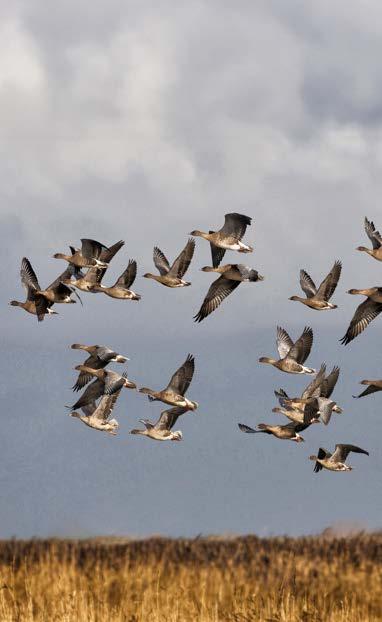
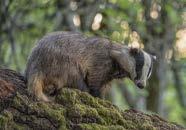
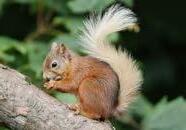



A
There’s a magical day in each season, or rather, a few salted moments of shift –an atmosphere, a temperature, a smell; the sound or sight of a particular bird or insect – that announces, softly, the next season is waiting in the wings.
We feel it bodily, sensually and often emotionally, too. Feelings that stir a raft of associative memories, that still connect us deeply with the earth’s turning, and all the other life that experiences it with us. It’s particularly powerful in spring and autumn – the year’s morning and evening, if you like – but perhaps it’s most poignant in autumn. A sign that life is moving inexorably forward, that things must change, end, and begin to begin. If we nurture a connection with nature, there is comfort and reassurance to be found.
Now, having come unsettlingly early this year, it is fully autumn, and those salted moments of shift are already beginning to prep invitation cards for winter. But not before the trees ignite in a blaze of warm colour, showing themselves in new light: fiery dogwood, toffee Beech, buttery Hawthorn and (my favourite) golden-syrupy Field Maple.
I love those evocative autumnal smells too – flowering ‘tods’ of ivy that buzz with late life, the mustysweet, beetroot warmth of tar-spotted Sycamore leaves floating down to earth, feeding and sheltering so many tiny, important lives. All this and more is a beautiful, slightly melancholy poem to me, that I associate with: Forest’s Robe: Penhaligon’s Scented Treasury of Autumn Verse and Prose. Opening it now, the perfume still lingers.
I love, too, that though the last Swallows and martins have just left
us, wild geese and winter thrushes are coming back from the north and east, with their wintry ember and ash colours. Our local populations of Blackbirds, Robins and Starlings are swelled, too.
As the days shorten, those of us who aren’t particularly early risers witness the daily magnificence of sunrise. The birds’ commutes begin to chime with ours – Rooks and Jackdaws from their roosts to the fields and back; gulls from their night-safe reservoirs and lakes, uplit with glory at sunrise or sunset, fly above our homes and workplaces to feeding grounds and back again.
I love the first appearance of the constellation Orion, cartwheeling over the wood behind the house, and the view of the big black down beyond, when the first storms have blown leafy holes through the same wood.
It’s a season we must get out and wear, to feel it fully, to know its place in things – and our place within that. To take and make our own comforts and delights, to build our resilience, perhaps try new things, make new discoveries.
Even when an irrational fear of House Spiders, which become active in October as they breed, drives me from the house, I can find beauty in the more manageable marvel of Garden Spider webs that sparkle in dew or rain, or frost that lowers their slack rigging as they sail between grass stems. Knowing how fleeting and precious it all is.

Nicola
is a columnist, nature writer and award-winning author. Her latest book is Ghosts of the Farm nicolachester.com or @nicolawriting


Have a go at painting this Redwing, then bring your own photos to life
I can hardly remember a time when I didn’t paint. By the age of 10, I wanted to be a professional artist. Now, my art is inspired by my curiosity of the world; painting something forces you to look closely at it with patience. Here are my tips for getting started:
1. Get a decent drawing down to give you confidence at the painting stage.
2. Build up slowly. Using plenty of pigment, slowly add layers, ensuring that each layer below is dry first.
3. As you go make sure your water is always clean. Don’t let it go muddy. For this piece, I used Cass Art paints, but the colours listed are standard watercolours used by other brands. Follow these steps or follow your own ideas. The best results come from enjoying the process and having fun! Turn to p66 to find out more about your garden Redwings.

1. Take some clear photographs to work from, or find some online. You could trace over these for the shape as you’re getting started.


2. Begin by sketching your subject, ensuring the outline is accurate. Then carefully develop details. Good preparation is essential.
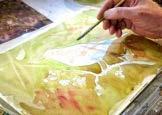
a

5. Mix Burnt Umber and French Ultramarine and paint the plumage in the direction it lies. Wet the paper on the belly first to create a soft, blurred effect.

6. Apply a wash of Cadmium Red and Winsor Orange to the underside of the wing. Add loose washes of different colours to the background to build depth.

RSPB Sparrowhawk® binoculars
8.5 x 42 (£850) Elevate your birding and wildlife watching with these lightweight and compact binoculars. See your favourite species up close through the crystal-clear lenses. Complete with superior low-light performance and a rainguard, these robust binoculars will be your go-to pair whether you’re birdwatching from your window or out and about
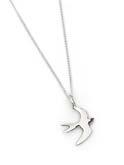
now
Sterling silver Swallow necklace by Blackbird (£40)
Show off your love of birds with this sleek necklace made from recycled material. Presented in a gift box, this charming piece would make a lovely gift.

l RSPB Garden wall clock (£30)
It’s easy to lose track of time when you’re enjoying nature, so this stylish and functional wall clock will come in handy when you’re out in the garden.

7. Once dry, add a variety of colours to enrich the background. Then refine the details on the beak, feathers, legs and twigs. Paint the berries.
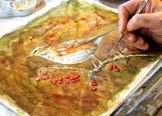
8. Finally, use Permanent White gouache – an opaque watercolour – to add fine details. Focus on the lighter plumage, eye highlights and berries.


Endemic
James HardingMorris £20
Conservationist James shines a spotlight on the animals, plants and fungi unique to Britain and those working to protect them.
Homeward
Bound Hamza Yassin, £24.99 Hamza shares joyful tales from his exploration of wildlife across the British Isles, as well as his time as a cameraman.


Birdland: A Journey Around Britain on the Wing Jon Gower, £22
A celebration of British birds and an in-depth look into the challenges they’re facing.
Neurodivergent by Nature
Joe Harkness, £18.99
A look at how neurodivergent people seek solace and understanding in nature.
Shopping with the RSPB Shop helps keep our world wild. Profits go to conservation, and all products are as nature-friendly as possible. RSPBshop.co.uk
Providing crucial habitat, the UK is a haven for both resident and migratory ducks

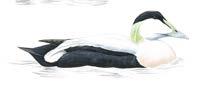

The UK’s heaviest and fastest flying duck, the Eider spends its life on or around the sea. They have a short neck, large body and head with a long, wedge-shaped bill. Female and juveniles are mottled brown with dark barring but have the distinct long forehead with a grey bill. Young males are a mix of black and white. Adult males are white with a black crown, flanks, belly and tail. Their breast is a slight tint of pink with a lime green head.


These ducks have a shovel-like bill which they use across the water’s surface. Females are a mottled brown with white under the wings and a dark belly. They have dark grey bills with orange edges. Juveniles look similar to females. Breeding males have a dark green head, white breast and neck with chestnut flanks. In flight, look out for blue forewings.
Enjoy our comprehensive guide to every UK winter duck species when you switch to digital. See page 82.

A small duck with a delicate bill, seen in a variety of locations. Females are similar to a female Mallard, mottled brown with a dark crown and a small bill which often has orange towards the base. Juveniles and males in eclipse can look very similar to the females. The breeding male has a chestnut head and a dark green eye patch which extends down the back of the head. Both have a bright green wing patch in flight.


Slightly larger than a Mallard, the Pintail is an elegant duck with a long, thin neck and delicate bill. The males have chocolate brown heads with a white stripe running down the neck and a long tail. The females have a shorter tail and are mottled brown with scalloped brown and buff flanks. They are paler compared to other female ducks.


One of our largest ducks, seen around the coast but also at some inland sites. Both male and females are mainly white with a chestnut band around their breast, a dark green head and neck along with a bright red bill.
Alice Hardiman, Director of Campaigning and Mobilisation
What is your role and what does it entail?
My job is to help RSPB members and supporters to use their voices to call on governments to make positive changes for nature. I do this by working closely with my colleagues in policy advocacy. They talk to civil servants and politicians to develop solutions to the challenges
Drive on wooded lanes and near hedgerows on calm, mild nights in winter and you can’t miss the fluttering forms in the headlights. These are male Winter Moths (Operophtera brumata) and they’re looking for mates. The females they seek are very different animals; almost wingless and unable to fly. They crawl up a tree trunk to a suitably lofty height where they emit the pheromones that will attract a male. Look for them in woods with a torch any time from October until January.
This moth, although rather dowdy, has extraordinary biology. Not only has the female dispensed with flying, but they are also able to tolerate winter temperatures by producing compounds that stop them from freezing. The eggs, once laid on twigs or in fissures on bark, remain dormant until the spring, awaiting the flush of new plant growth. Oak, birches, Hawthorn and heathers are favoured, but they will use a wide variety of food plants. When they hatch, the caterpillars set to work devouring the soft, new leaves. In turn, the huge numbers of Winter Moth caterpillars are an important food source for many bird species. Should they exhaust a particular food-plant, the caterpillars can even ‘balloon’ to pastures new, spooling out a long line of silk that carries them aloft via electrostatic repulsion – much the same as spiders. By June, fully grown caterpillars tumble to the ground to pupate in the soil – awaiting the shorter days and falling temperatures that will trigger adult emergence.

Dr Ross Piper is an entomologist, zoologist and explorer. Visit rosspiper.net or @DrRossPiper

facing nature and advocate for these. I then work with them to provide key information about how and when to take action to our supporters.
What has been your biggest success so far?
I’m really proud of our current project to defend the naturefriendly farming budget. This is really the RSPB at its best. We combined our scientific
and economic research, policy expertise and farming expertise both on our sites and in our work with farmers to inform this campaign. We then mobilised 100,000 people to sign the petition and thousands also wrote to their MPs. It involved so many people, and it showed the strength and power of our wonderful members. And we achieved the right
outcome for nature, which was great.
What can individuals do to influence decision makers?
I believe campaigning is the single biggest impact anyone can have as an individual. Writing to your MP and exerting that public pressure on the government has a real impact. I see it time and time again in my role; it sounds
cheesy but when we act together we really can make a difference. If you’d like to do more, please sign up with us to be a campaigner.
Scan for more
Discover what you can do at rspb.org. uk/action fornature
Designed by nature Dominic Couzens
These birds are around us every day, but for how long?
People often ask me: “How long do they live?” The answer is complicated. You cannot age a bird by looking at it; there are usually no outward signs to tell, say, a four-year-old from a 20-year-old bird. Life expectancy also varies between species (see across for some averages). Put briefly, most bird lives are shorter than you might expect but can be much longer, too!
The reality for many of our favourite birds is shocking. Over 80% of fledged Robins die in their first year of life. The losses are enormous, with predation, disease and starvation taking their toll. Very young birds cannot store enough fat to survive the night if they suffer a day or two of bad weather. Within the populations of many small birds, around 50–60% of adult birds also die each year, leaving a truly paltry adult life expectancy – for Robins, one–two years.
The picture is better for larger birds, and you can sometimes take a stab at a life expectancy from a species’ biology. Birds that start breeding late and have small clutches of eggs will have longer lifespans. Seabirds are unusual for their longevity; the pigeon-sized Puffin has a life expectancy of 18 or more years, while both a Feral Pigeon and a Woodpigeon should manage just three. It’s thought there are fewer predators at sea. Interestingly, tropical birds also live longer than temperate birds, living in a more stable, reliable environment.
In human societies, as you age, your expectancy of further life diminishes. This isn’t the case in birds. Once they reach adulthood, their life expectancy plateaus, so you might well have the same pampered Robin in your garden. Roughly one in 1,000 small birds lives to 10 years. The oldest ringed House Sparrow was 12. These outliers are surprising. In 2025, an Oystercatcher was ringed in the UK at the ripe old age of 43, and there is a famous female Laysan Albatross that is still breeding at at least 74. Albatrosses could live to 100, and perhaps parrots, too, but research hasn’t yet proven this.

Dominic
Couzens is a wildlife writer and tour leader living in Dorset. Visit birdwords.co.uk or @DominicCouzens
Average life expectancies of common species

Discover something new about some of your favourite birds in this fun book with a



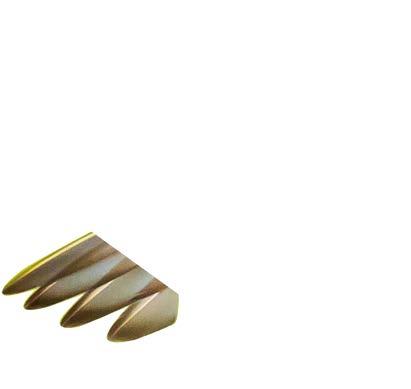
The piping call of the Redshank is a distinctive sound across saltmarshes. Marianne Taylor explores what declines in this species mean, and how new work is turning the tide
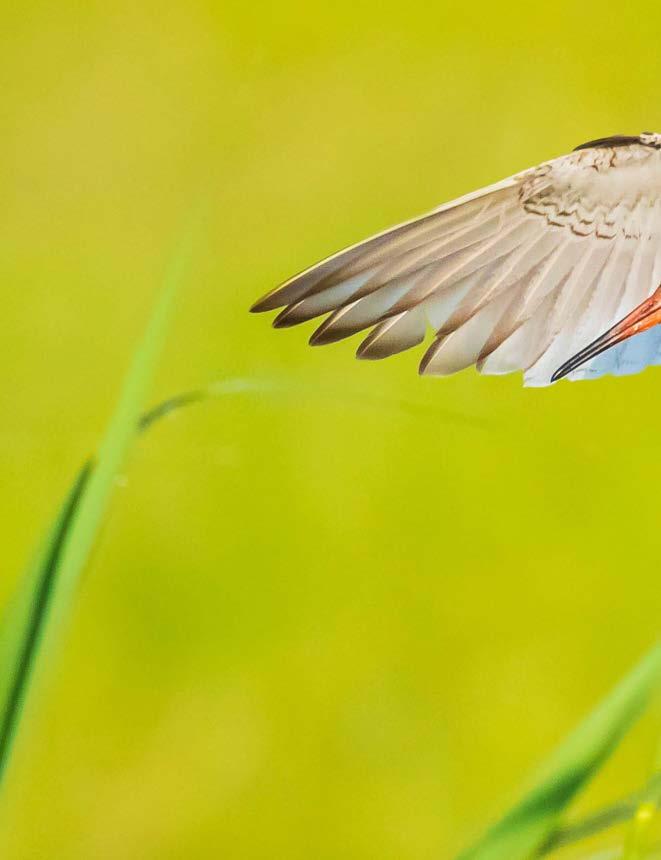
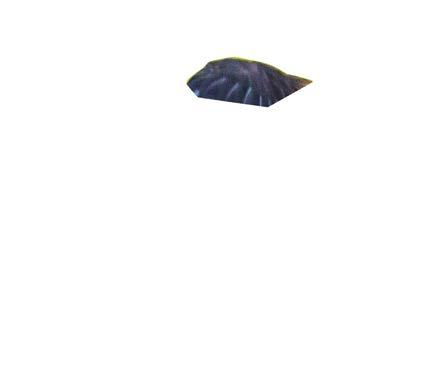
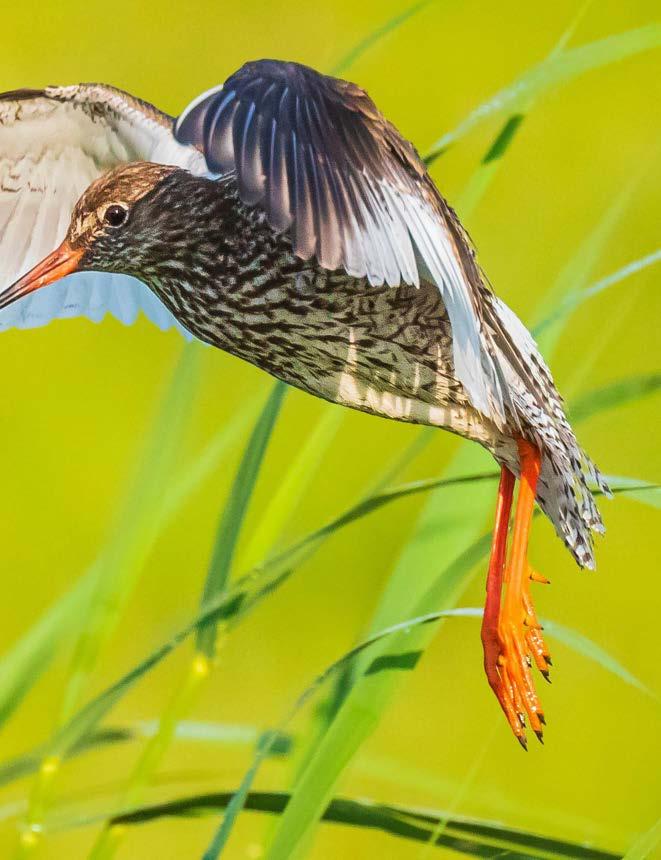
Scan for more

To hear the call of the Redshank head to rspb.org. uk/redshank or scan the QR code
We had not been this quiet all day. My family of five, squeezed into one corner of the nature reserve hide, watched as the Redshank picked its way along the lagoon shoreline. The early evening sun turned its eponymous legs fluorescent as it slow-stepped closer, until it was under our noses.
Previous: In flight, the Redshank displays white rear edges to the wings and a white ‘V’ up the back
1. Redshanks are named for their bright legs
2. A student monitors a Redshank nest
3. Breeding Redshanks are often seen perching on fence posts
4. Redshanks roost in shallow water
I was 10 and this was my first close look at a wader. It was the perfect finale to my Young Ornithologists’ Club (YOC) birdrace. The miracle was borne out later when my sister – hitherto a staunch non-birder – asked our parents if she, too, could join the YOC. As my birding life progressed, I found Redshanks roosting above the tideline on wild winter beaches, and feeding along muddy channels that wound through saltmarshes. In spring and summer, breeding adults leapt up from the criss-cross creeks of Romney Marsh, flashing white-edged wings while delivering a startling volley of plaintive, ringing calls. It was an ‘every-wader’, an often-present comparator for scarcer species.
Saltmarsh specialist
The decline of a widespread species isn’t always obvious, especially if you mainly birdwatch on nature reserves, where species may fare well for longer. Yet data from the UK’s Breeding Bird Survey – a long-term monitoring project jointly funded by the RSPB, British Trust for Ornithology (BTO) and Joint Nature Conservancy Committee (JNCC) –revealed a UK-wide fall in Common Redshank numbers of 45% between 1995 and 2023.
In the UK, Redshanks breed on saltmarsh, wet grassland and machair (coastal grassland, restricted to a few places in northern Scotland and the west of Ireland). These damp habitats offer dense vegetation for nesting and abundant invertebrate prey. Saltmarsh (which adjoins the sea coast and is regularly inundated by saltwater), is most vital, holding more than 50% of the UK’s breeding population. “National surveys show that between
‘Redshank need long tussocks of vegetation to nest in, and surrounding shorter areas for feeding’
1985 and 2011, the number of breeding pairs on British saltmarshes fell by 53%,” says Audrey Jost, Coastal Species and Habitats Officer on the RSPB’s Global Species Recovery team. Audrey’s work for the past year has been funded by Natural England and the RSPB as part of the Actions for Birds in England partnership, and also by the LIFE Programme of the European Union as part of LIFE on the Edge.
Dr Lucy Mason, Senior Conservation Scientist for the RSPB Centre for Conservation Science and involved with the Saltmarsh Redshank Recovery Project, explains that, while adult survival rates are stable, breeding success has fallen dramatically, partly due to changing habitat management. “Historically, many saltmarshes would have been grazed with livestock, but nowadays at many sites the grazing has been abandoned, or conversely grazing intensity has really increased,” she says. “Redshanks need long tussocks of vegetation to nest in, and surrounding shorter areas for feeding. That structure is best given by cattle grazing at very low densities, ideally after the Redshanks have finished nesting.”
The project’s goals include delivering advice on Redshank-friendly practices. “We are providing a saltmarsh toolkit for land managers. Practicalities, such as where do you put your animals the rest of the year? How many cattle do you need?”
Lucy also describes how similar advice provided to land managers by the RSPB’s Advisory team is leading to innovations in land management elsewhere. “As part of the Clyde Valley Wader Initiative in Scotland, farmers trialled growing a brassica crop – a genus of plants in the mustard and cabbage family – and then putting livestock in those fields to eat the tops. The stubble that’s left fallow from early spring proved to be really good for waders in general.” We’ve also trialled temporary electric fence enclosures.
1 Human disturbance is a growing problem for Redshanks. Breeding birds leave eggs or chicks unattended when they respond to a perceived threat, while in winter they waste precious energy if flushed from feeding and roosting areas. Keep your distance.
2 Keep dogs on a short lead when visiting habitats that hold ground-nesting birds and never allow dogs to chase any birds.
3 You can contribute data by logging sightings on apps such as BirdTrack and eBird, and supporting the RSPB means helping to fund vital research and conservation work.
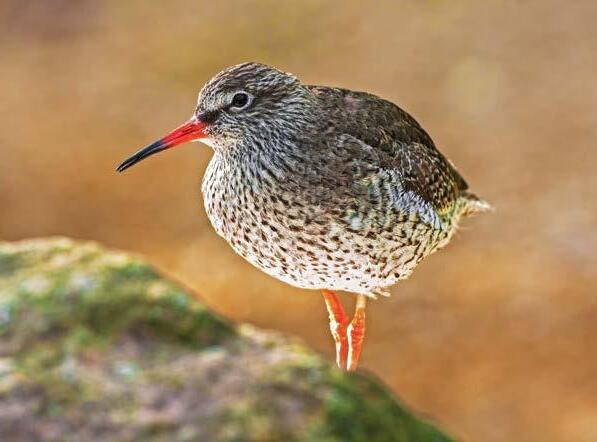



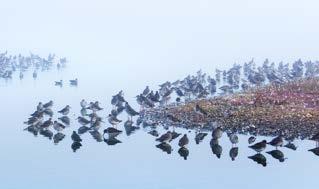
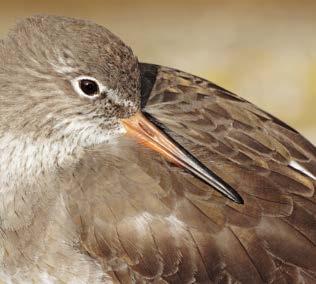
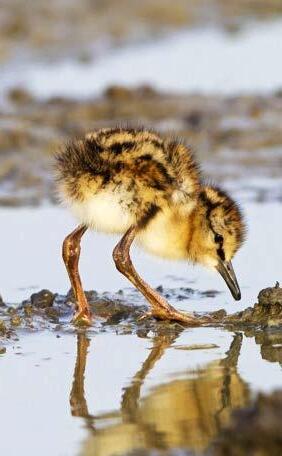
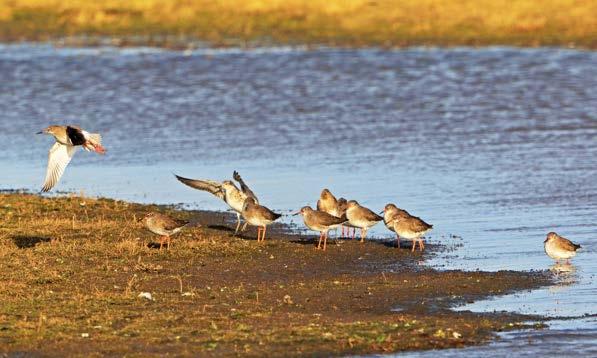
‘Reversing the fortunes of this species requires co-operation
Under pressure
Climate change is also damaging saltmarshes and causing them to shrink, as Audrey explains: “Rising sea levels push saltmarshes inland, but sea walls or other hard defences prevent them from moving, effectively trapping and shrinking the habitat over time.” This is known as coastal squeeze, and it leads to smaller pockets of habitat which provide less food and fewer nesting opportunities, and may give predators easier access to the reduced breeding population.
Here, the ‘wrong’ type of grazing can make things worse. “Livestock cause a lot of nest trampling if they are put out on the saltmarsh in spring, and sheep also often eat eggs and chicks or cause disturbance which attracts other nest predators,” says Lucy. “Excluding livestock from saltmarsh until July, or providing temporarily fenced-off areas, can provide livestockfree havens for nesting Redshanks while still keeping the habitat in good condition.”
Predator pressure for Redshanks nesting on wet grassland can be mitigated by predator-exclusion fencing, as can relatively simple habitat improvements. “Redshanks have been increasing on RSPB wet grassland nature reserves, but declining on that habitat in the wider countryside,” says Dr Malcolm Ausden, Principal Ecologist for the RSPB. “However, numbers can increase quickly when you create good habitat.
5. Redshanks can be seen in large numbers at Snettisham, both breeding on the saltmarsh and wintering on the mudflats
6. Nesting typically takes place between April and June
7. The base of their medium-length bill is orange-red, like their distinctive legs
8. Around half of Redshanks wintering in the UK may come
They particularly like shallow, temporary pools on grassland, a feature that is rare in the wider countryside, but usually easy to create on wet grassland nature reserves.”
Seasonal challenges
Our breeding Redshank are joined by many more in winter, as Dr Guy Anderson, Migratory Species Specialist for the RSPB, explains. “Ringing data tell us that Redshanks that winter in the UK include British and Irish breeders; much of the Icelandic breeding population; and some Scandinavian and northern European breeders.” Our wintering population has suffered a 21% decline since 1998, with habitat loss on wintering grounds and migratory stop-off points a key factor. “In the 1990s, the Cardiff Bay Barrage project converted intertidal mudflat into a lagoon, destroying feeding habitat and causing a significant drop in the survival rates of Redshanks that wintered there and were displaced. In other words, it killed birds,” says Guy. Reversing the fortunes of this species requires co-operation and effort on multiple fronts, and today there are many people and projects involved. A whole array of other wildlife stands to benefit too – the unique assemblages of invertebrates and plants on which Redshanks depend. These wetland ecosystems contribute to the planet’s wellbeing, acting as carbon sinks and protecting water quality. Nicknamed ‘sentinel of the marshes’ for its vigorous, high-volume response to danger, the Redshank’s visibility means it serves also as guardian for the wider wetland world.



Marianne Taylor is a life-long birder and wildlife-watcher. Her books include RSPB Pocket guide to British Birds, RSPB British Birds of Prey, RSPB Seabirds and RSPB Garden Birds

Smaller, squatter
Straight, shorter, dark-tipped red bill
Face lacks strong markings
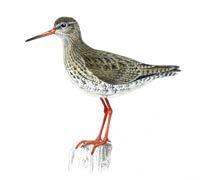
Plumage mid-brown, paler below (dark spots on underside in breeding plumage)
• In flight, wings show white trailing edges Usually wades in shallow water
• Piping calls
: Work to provide wetland habitat for species such as the Redshank also captures carbon. Another way the RSPB is helping to tackle the climate crisis is by working with businesses to harness renewable energy and provide wildlife habitats (p29).
73-year-old sailor Pauline Rook shares how Turmeric+ Gold helps her keep steady as she goes.
‘Both my mother and grandmother found it harder to stay active as they got older, so when my knees began waking me up at night I wanted to do something proactive to help myself.’
‘Turmeric was recommended by a nutritionist who suggested I make a not very tasty drink, which I didn’t fancy at all. So when I saw an advertisement for Turmeric+ Gold from FutureYou Cambridge I thought I’d try that instead.
‘It was very good and worked wonders. But when I stopped taking it and tried a cheaper supplement, it wasn’t the same, so I went back to Turmeric+ Gold. That was about 10 years ago and
I’ve not had a problem since.’
The key active ingredient in turmeric is curcumin, but it’s difficult for our bodies to absorb.
Developed by Cambridge scientists, Turmeric+ Gold uses a patented Curcuma Phospholipid Complex that makes curcumin 30 times more absorbable than standard turmeric.
‘Our formulation uses a plantbased lecithin to mimic the way the body naturally absorbs curcuminoids after eating turmeric cooked with fat,’ explains Dr Miriam Ferrer, PhD, Head of Product Development. It’s also enriched with vitamins C and D, which contribute to normal

‘It was very good and worked wonders’
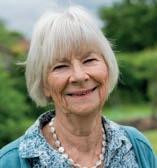
cartilage and muscle function.*
Turmeric+ Gold is now a bestselling supplement for joint health, certified by Informed Sport for use by athletes.
‘Recently I went dinghy racing,’ says Pauline. ‘I’m by far the oldest active dinghy woman sailor in the club, but even after hanging over the toe straps in rough seas, my knees were fine.’
• 30 times more absorbable than standard turmeric: Powered by the patented Curcuma Phospholipid Complex formulation, Meriva®.
• Science-backed: Uses sunflower lecithin to naturally enhance absorption.
• Plus essential vitamins: C and D to support healthy bones, muscles and joints.


*Turmeric+ Gold contains vitamin C which contributes to normal collagen formation for the normal function of cartilage and bones. Vitamin D contributes to the maintenance of normal muscle function. Introductory offer valid for new UK customers only. Offer expires 31st December 2025 and cannot be used in conjunction with any other promotions. Cancel any time, without obligation. See FutureYouHealth.com/pages/offers?coupon=TGF391 for full terms and conditions. Discover why thousands of people trust Turmeric+ Gold for joint support, backed by over 40 human studies. EXCELLENT Over 14,000 reviews


Simon Barnes

Simon Barnes is a bird and wildlife writer and author.
Too much of our wildlife is in sharp decline. Look up the reasons: again and again, you find the same thing. Intensive and industrial farming. Farming that leaves no room for anything that lives except more crops. Travel through that kind of farmland, and it looks almost sterile. There’s probably more biodiversity in your kitchen.
Some farmers have been known to get a bit defensive about this. But that response is a bit old school. There’s a change of thinking in many places, with farms striving to go naturefriendly. Since the end of World War Two the RSPB has been working with farmers to show that it’s not a choice between food and wildlife. You really can have both. You can farm profitably on land that’s jumping with nature.
“Ha! That’s easy for you to say”, many might think. “You try a bit of real farming; you’ll soon be singing another tune.”
So, 25 years ago, the RSPB bought a farm. Hope Farm in Cambridgeshire. It’s 181 hectares, about 450 acres. Not huge, but a decent size. Any farmer would be glad to take it on. It’s right in the heart of the intensive agriculture belt: you can walk for miles and never see a hedge, never hear a Skylark, never set eyes on a butterfly. And the RSPB began to farm it. Farm it for profit.
In 2024, Hope Farm made a profit of £110,000. This isn’t organic farming either: just everyday agriculture. They started out with just wheat and oilseed rape: as ordinary as it gets. The strategy is based on seven different crops,
‘Hope Farm isn’t a nature reserve with a few token bits of agriculture. It’s a profitable working farm’
primarily cereals. It’s a working farm run by contractors, and it makes a decent profit, subject to market shifts and rotten weather conditions, just like any other farm.
A quarter of a century is worth celebrating, so I went along to cheer. There was Beccy Speight, Chief Executive of the RSPB, opening the show, explaining how the number of butterfly species on the farm had quadrupled while, above her head, a couple of Large Whites were in aerial combat. Who needs PowerPoint? Georgina Bray, Hope Farm Manager, took us for a walk and had to raise her voice so that we could hear her above the Skylarks. It was hard to maintain discipline: the disorderly crocodile of conservationists kept slipping off to check out the field margins, which were vibrant with Lady’s Bedstraw, Knapweed, teasels, and Tufted Vetch.
The deliberate conservatism of the early days has been set aside. The farm has been insecticide-free since 2018 and, as you can easily check online, it’s remained profitable as ever. They’re now trying more daring methods: an agroforestry project, which combines ground crops with trees, is showing promising results.
Hope Farm isn’t a nature reserve with a few token bits of agriculture. It’s a profitable working farm that also has nice field margins, wildflowers, seed mixes for birds, a few ponds, and a little woodland. The farming is not funded by the RSPB. That’s the whole point. The RSPB funds the research, and this is how we know that more than 2,000 species (animals, plants, fungi) have been recorded here in the past 25 years. But it’s a working farm – there’s a field of oilseed rape just like you find on the farm next door and the one beyond that. About 70% of land in this country is given over to agriculture. If farms were nothing but outdoor food factories we would soon find ourselves living in a country that’s no good for birds, butterflies, wildflowers and, ultimately, people. Food or nature? Both please. We can do it! Anyone who says otherwise faces an unanswerable counter-argument.
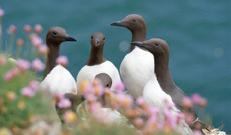
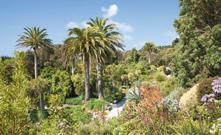
A Discovery of Britain’s seabird islands aboard the Ocean Nova 5th to 14th May & 14th to 23rd May* 2027



The seabird islands of the western British Isles are the envy of the birding world and yet it is not easy to sample the wonderful diversity of their character and come face-to-face with seagoing inhabitants. This unusual expedition cruise will appeal to those who wish to explore our coastal waters, observe the marvellous seabird and marine life and walk across untouched coastal wilderness areas. The focus of our expedition is the prolific birdlife but the region is also rich in historical and cultural heritage and with our naturalists and local guides we will discover some of the most remote and uninhabited islands that surround the coast of Britain together with inhabited islands such as Alderney and Rathlin.
Cruising aboard the 84-passenger Ocean Nova, we will be able to enjoy expedition cruising at its best. Our exploration of inlets, estuaries and protected coastal waters will be made all the more enjoyable by the use of our Zodiac landing craft which enable us to land in remote places such as St Kilda, providing for an unusual perspective and making the otherwise inaccessible readily available. This is a wonderful opportunity to see some of our most beautiful places and view some of the extensive birdlife. No matter your level of expertise you will find a warm welcome and a cornucopia of stunning sights and sounds.
OCEAN NOVA accommodates 84 passengers in comfortable cabins which feature sea-view and private facilities. In the dining room you are treated to delicious meals in between Zodiac landings and excursions and in the panorama lounge you can enjoy a drink with a breathtaking view of the surrounding landscape. This is where the onboard specialists entertain and educate you with lectures. There is also a library with panoramic views and a good selection of books. We have chartered the vessel for these sailings and the atmosphere on board is informal with time on board often spent out on deck keeping watch for wildlife.



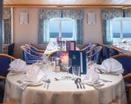
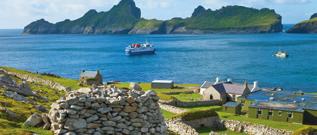

Day 1 Poole, England. Embark the Ocean Nova this afternoon. A transfer will be provided from Poole Railway Station at a fixed time. Enjoy welcome drinks and dinner as we sail this evening.
Day 2 Alderney, Channel Islands. Arrive in the Channel Islands and spend the morning on Alderney where our onboard team will lead a series of walks to explore the island. Visit the island’s only town, St Anne, which has all the old world charm of a Normandy village with tiny squares and pastel shaded cottages and shops. Those feeling active can join a walk to see the German fortifications and Victorian forts along the coastline before arriving at Les Etacs gannet colony. These rocks are situated just 100 metres offshore and are home to 6,000 pairs of gannets. Return to the ship for lunch and maybe join a lecture during our afternoon at sea.
Day 3 Isles of Scilly, England. Our day in the Isles of Scilly will depend on weather and sea conditions but we hope to visit traffic-free Tresco, walking its idyllic lanes from the beach to the famous subtropical Abbey Gardens. Defying the Atlantic weather, this miracle of a garden is home to more than 20,000 species of plants from over 80 countries. Later we hope to land on St Agnes, the most south-westerly community in the UK. Surrounded by rocks and reefs, this delightful tiny island offers marvellous coastal walks. En-route we plan to sail past the nearby island of Annet, the second largest of the uninhabited islands and a bird sanctuary. We will cruise by to see the coastline alive with puffins, European storm petrels and shag.
Day 4 Skomer Island & Grassholm Island, Wales. We awake this morning off the Pembrokeshire Coast at the Island of Skomer. One of the most important wildlife sites in Northern Europe, this island has fantastic birdlife including 6,000 pairs of puffins, countless numbers of guillemots, fulmar, kittiwakes and the elusive Manx shearwater and storm petrel. We will use our Zodiacs to take a closer look and may also see some of the resident seals. Return to the ship for lunch as we sail to Grassholm, one of the world’s largest gannetries with over 34,000 breeding pairs.
Day 5 Holyhead, Wales & Calf of Man, Isle of Man. Over breakfast we arrive at Holyhead,
adjacent to Anglesey, with its spectacular sea cliffs. Here we will visit the RSPB’s reserve at South Stack, a beautiful but fragile maritime sward and heathland which is home to a large population of guillemots and razorbills. If we are lucky, we might also see some choughs. On a choice of walks, we will also see Ellin’s tower, a Victorian folly, and South Stack lighthouse built in 1809. Returning to the ship for lunch we hope to arrive in the late afternoon at the Calf of Man, a 600 acre island situated off the southern tip of the Isle of Man, and home to thousands of seabirds including Manx shearwater, kittiwake and razorbill.
Day 6 Ailsa Craig, Scotland & Rathlin Island, Northern Ireland. In the early morning we will anchor off the granite island of Ailsa Craig. This tiny island, just 2.5 miles in circumference is an RSPB reserve and home to the third largest gannet colony in Britain. We will use the Zodiacs and cruise the coastal waters for a closer look searching for puffins, guillemots and gulls. Sail in the late morning towards Rathlin Island. Located just a few miles from the North Antrim coast, Rathlin has been settled for more than 6,000 years. Today, there are only 80 or so inhabitants, whereas before the famine there were 1,200. Enjoy a guided walk which will take in the prolific seabird life with astonishing numbers of auks, kittiwakes and grey seals. This evening we will sail past the magnificent cliffs to the north of the island which are home to the largest seabird colony in Ireland.
Day 7 Staffa & Lunga, Scotland. Overnight we will sail to Staffa, where the perpendicular rock face features an imposing series of black basalt columns, known as the Colonnade, which have been cut by the sea into cathedralesque caverns, most notably Fingal’s Cave. Weather permitting, we will use our Zodiacs to explore closer. We continue to Lunga, the largest of the Treshnish Isles where the prolific birdlife includes storm petrels, puffins, kittiwakes and Manx shearwaters.
Day 8 St Kilda & Stac Lee, Outer Hebrides. Arrive this morning at St Kilda, a remarkable uninhabited archipelago some 50 miles beyond the Outer Hebrides. Dominated by the highest cliffs and sea stacks in Britain, Hirta, St Kilda’s main island was occupied on and off for at least 2,000 years, with the last 36 Gaelic speaking inhabitants evacuated at their request in 1930. Immediately after the evacuation, the island was bought by the Marquess

of Bute to protect the island’s thousands of seabirds including puffins and fulmars, and in 1957 it was bequeathed to the National Trust for Scotland. The local ranger will join us on board before our expedition staff lead several guided walks on the island. This afternoon we cruise past two of the largest gannetries in the world at Stac Lee and Boreray. These impressive stacs rise 170 metres from the sea and are home to up to 60,000 breeding pairs of northern gannets.
Day 9 Shiant Islands & Isle of Lewis. This morning we will board the Zodiacs for a cruise around the spectacular basalt cliffs of the Shiant Islands, a group of little islands located a few miles off the shores of the Isle of Lewis. This is an excellent place to spot puffins, razorbills, guillemots, seals and hopefully white-tailed eagles. Over lunch we sail the short distance to Loch Sealg on the southern coast of Lewis where we can stretch our legs as we explore the abandoned, former crofters, village of Stiomrabhaigh.
Day 10 Oban. Disembark after breakfast. Transfers will be provided to Glasgow Airport and Glasgow Central Railway Station at a fixed time.
Please note that the 14th May departure operates in the reverse direction to that shown, from Oban to Poole and the full itinerary can be viewed online.
Prices per person based on double occupancy start from £4995 for a Category 1 cabin.
Nine nights aboard the Ocean Nova on a full board basis • House wine, beer and soft drinks with lunch and dinner • Noble Caledonia expedition team • Shore excursions • Gratuities • Transfers • Port taxes.
NB. Ports and itinerary are subject to change. All special offers are subject to availability. Our current booking conditions apply to all reservations. Travel insurance is not included in the price. Zodiacs will be used regularly during this expedition.



















“Just







Wool is naturally antibacterial.
Wool is so dry Dust Mites hate it.
Wool regulates your temperature in bed even 2 di erent temperatures in the same bed.
And you don’t need to wash it, just air it on a nice sunny day.



Wool is naturally breathable and will wick away moisture leaving the duvet dry and mould free.
It’s so clean and cooling it makes it ideal for Asthmatics, eczema, and allergy su erers.
A Baavet is made from completely natural and sustainable materials.
Love your Baavet and it will last you a lifetime







YOU CAN’T BUY BETTER THAN A BAAVET, NATURALLY BETTER FOR YOU AND NATURALLY BETTER FOR THE PLANET So what makes a Baavet so special?
Baavet buys its wool directly from British farmers paying them a premium price for their wool. We give you a 30 day no quibble money back guarantee.
Your Baavet is available in 4 di erent weights and prices start from £115 for a Super Light single
We also make wool pillows, mattress protectors, and wool mattresses. All our products are British made using British wool. To buy online or for further details visit: www.baavet.co.uk or phone 01766 780 780 to speak to someone from our friendly customer service team.



With careful planning and management for nature, renewable energy and wildlife can go hand in hand. Emma Pocklington goes to see for herself
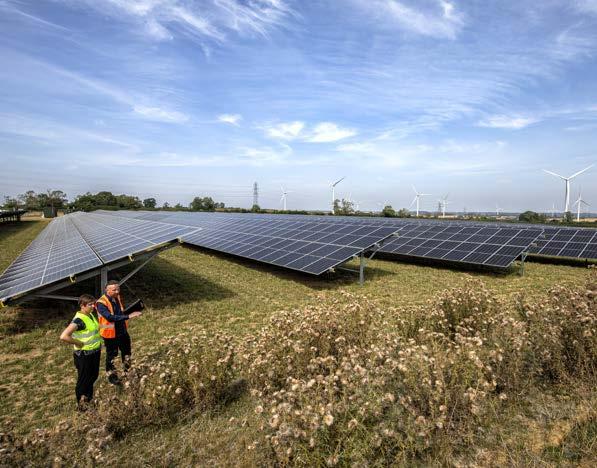
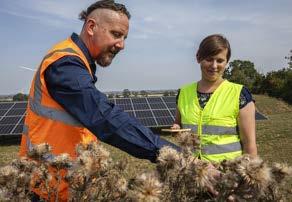
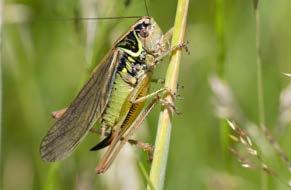

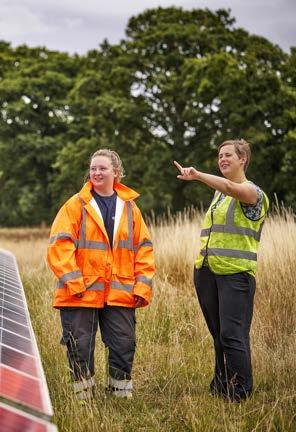

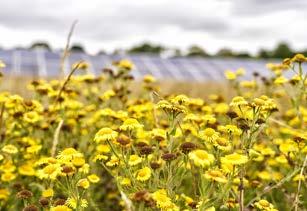
The field was one of those places where the grass was alive. The very ground beneath my feet teemed with life. As I walked, tentatively to avoid the Rabbit holes, grasshoppers sprung away from me and a Gatekeeper butterfly fluttered up in indignation. I heard a cry and, pausing to look up, saw Swallows hunting overhead. Spotted Flycatchers performed mid-air acrobatics and a Great Spotted Woodpecker clung to a nearby fencepost. Completing the scene were regimented rows of solar panels.
I was at Little Bear, a solar farm just outside Exeter in Devon. As I approached the site, the rows of panels had looked uninteresting, but this site is far from it; it is a place managed for nature and teeming with life. The four fields are grassland lined with native hedgerows and oak trees, many of which contain nest and bat boxes. There’s a small pond and a wildflower meadow. Bug houses have been nailed to the fence posts. Tree planting is under way, as are surveys to understand how bats use the site.
Little Bear is an example of what a solar farm can be. With concerns about solar farms rising, the RSPB is working hard to influence the development of these sites to make sure they are as nature friendly as possible. Climate change is the greatest long-term threat to nature and the RSPB supports building more renewable energy. However, these projects must consider nature as much as any other development. All renewables, be they solar farms, wind turbines or hydroelectric, must be planned and managed carefully to minimise harm to nature and enhance biodiversity. Done right, nature and renewables can thrive in harmony.
Bluefield took control of Little Bear when the site was earlier in its journey to becoming more biodiverse. But in the space of just a few years it has been transformed.
So what are the facts? Every solar farm is different, but in my short visit to Little Bear I saw plenty of wildlife, and studies by the RSPB back this up. Dr Joshua Copping, RSPB Conservation Scientist, has carried out studies into wildlife on solar farms.
“In our recent study we focused on breeding birds, and found that solar farms managed with nature in mind can host a whole suite of bird species from farmland to woodland birds,” says Joshua. “This included those listed as Red and Amber Birds of
Conservation Concern such as Linnet, Corn Bunting, Yellowhammer and Greenfinch. And it’s not just birds, other research has shown that sites with wildflowers and structurally varied grassland can support bees, butterflies, other pollinators and small mammals.
“One clear thing from research is that wellmanaged solar farms support more breeding birds than surrounding intensive arable fields. Intensive agriculture often leaves little room for wildlife, but species-rich grasslands under and around solar panels can reverse that trend.”
Of course, what really matters is how any site is managed. Any site that is poorly managed, whether it’s a solar farm, intensive farmland or housing estate will squeeze out nature, while farmland in good agri-environment schemes or housing developments with high-quality green infrastructure can play a big role in supporting wildlife.
“Solar farms aren’t a replacement for highly specialised habitats such as ancient meadows or wetlands,” Joshua adds. “Species such as Lapwing and Skylark that require open areas with long lines of sight may be negatively impacted by solar farm development.” But where habitats are used side by side, in a patchwork, the additional feeding for these species in solar farms (where grass is left to grow and seed heads left standing) could support birds nesting in nearby arable fields. Well-managed solar farms are just a piece of the puzzle in a network of habitats.
Previous: Paul and Emma at Yelvertoft
1. Paul shows Emma thistle seed heads at Yelvertoft, perfect for Goldfinches and Linnets
2. From the air you can see how aspects of the Yelvertoft landscape work for nature, with meadows, hedges and swales
3. Roesel’s bushcricket
4. Aurora Bartlett shows Emma around the Little Bear site
5. A Common Blue butterfly
6. Common Fleabane grows in the fields at Little Bear
Collaborative working in this sector is key, and the RSPB is pooling its knowledge with businesses to make nature-friendly renewables a reality. Paul Wilkinson is a Senior Business Conservation and Ecology Adviser within the RSPB’s Business Conservation Advice team. His role is to provide businesses with insights and guidance on how they can be more sustainable and help nature recover. Since 2021, this team has been working with solar farm and energy storage developer Lightrock Power, and more recently with Econergy and Elements Green to support the integration of best practices for nature into the management of their sites.
“The advice we are providing to businesses does not replace the ecological consultancy role, my role is to review the plans and add value on how to improve the Biodiversity Net Gain of the project and how to mitigate and recover some of our most vulnerable species,” explains Paul. “We advise on the planning, management and monitoring to make sure the new
‘Well-managed solar farms can host a whole suite of bird species from farmland to woodland birds’
‘When planning renewable energy it’s important that a strategic and spatial approach is taken’
solar farm has more nature than whatever was on site before. Compared to modern arable fields, these new grasslands can recover pollinators and insects to the benefit of breeding birds, as we have seen today.”
I met Paul onsite at Yelvertoft solar farm. Codeveloped by Lightrock Power and Bluefield, at just two years old this site is already showing what managing a solar farm for nature can do. It was a scorching hot August day, and we saw Goldfinches feeding from the abundant thistle patches and Swallows overhead; a Buzzard soared through the blue skies; we heard the rasping cronk of a Raven; and even saw Common Blue and Clouded Yellow butterflies feeding on the plentiful wildflowers. Michael Harrison, Field Site Engineer for Stern Energy, showed us around, pointing out the things that delight him on a daily basis – the Hares racing across the fields, a Badger sett in a copse and a Kestrel hovering overhead.
A plan for the future
Unlike Little Bear, where some wildlife features were fitted retrospectively, Yelvertoft was planned with nature in mind. Both approaches work – though planning and collaboration from the concept is likely to be much more effective – and neither inhibits the amount of energy that can be produced on site. In fact, allowing nature to take its course on land that was once farmed can help repair the soil. It can potentially lead to less flooding with the creation of swales and wetland features, increased plant variety with less chance of one species taking over and, when the farmer’s land is returned to them at the end of the contract, there is potential for healthy soil full of organisms, fungi and stored carbon due to the respite.
What’s more, having a solar farm on site doesn’t mean that the land can’t also be used for farming. At Yelvertoft sheep graze around the panels but on rotation, something the RSPB recommends. This means this land still works for the farmer while providing a variety of habitats perfect for a range of species – on our visit one field was grazed short and we saw ground beetles hunting between the herbs, while another was longer and dotted with late summer flowers as well as Common Blue butterflies.
For Paul, one of the most exciting things to come out of this work is the development of seed banks on sites, often long dormant in the ground. As we walk around Yelvertoft he quickly spots many plants and insects of interest, all signs that natural balance is returning here. In the swales, native pondweeds are
appearing, providing the right conditions for several dragonflies and damselflies to lay their eggs. In the margins, there is a clear division between the wetter plants, still lush and providing cover to singing bush-crickets, as well as vital nectar when the grasslands above are going to seed. As this habitat is left to recover, with minimal disturbance, the soil improves and threatened species of wildflower could possibly spring up. This in turn benefits insects and, moving up the food chain, rare birds and mammals.
The results so far look promising. “All the partnership projects to date have greatly exceeded the 10% Biodiversity Net Gain requirement,” Paul explains. “It is too early to report on the success of priority species, but research from established solar farms with mixed habitats looks good.”
Adding wildlife-friendly management to existing solar farms is certainly good practice, but the key to balancing renewables and nature is in planning. “When planning renewable energy, it’s important that a strategic and spatial approach is taken, to ensure that solar farms are built in areas that are of low risk to nature,” Paul explains.
The same is true of wind turbines. Samuel Wrobel, Senior Marine Policy Officer, is working to ensure seabird foraging needs are captured at the heart of planning. Working closely with The Crown Estate and UK Government, this is a vital step to try and avoid the key areas for seabirds as future windfarms are built. Where they know there will be conflict, the RSPB Marine team are working hard to come up with practical solutions for the Government and the wind industry to implement measures for seabird recovery (aka strategic compensation).
“Wind turbines can be a big problem for seabirds, especially if they’re in the wrong place,” Samuel explains. “It’s a tricky balance for us to get right, but built in the right place turbines are a vital tool in the move towards renewable energy, and have lower impact for nature.” Samuel’s work includes advising policymakers on how to avoid building offshore wind in the wrong places; how to build in a way to coexist with nature; and where those two things are not possible, how to compensate for the impact.
Far from being at odds with nature it is clear that, when proper consideration is taken, renewable energy can work in harmony with nature and may even provide a lifeline for some struggling species. The need for renewables is indisputable – they must be increased and now – but not to the detriment of nature. The climate and ecological biodiversity are intrinsically linked, and we need both for a brighter future.

Emma Pocklington is Editor of The RSPB Magazine. As well as working across all the RSPB titles, she has also written for BBC Wildlife and BBC Countryfile magazines.
We are Ambassador. Britain’s authentic no-fly cruise line offering affordable quality and the warmest welcome at sea. Our IMO Tier III compliant ships allow you to explore more of our destinations including the Norwegian Fjords, Scandinavia, Iceland and the Caribbean, than other cruise lines offer. Experience amazing entertainment, outstanding cuisine and no-fly convenience on our affordable sailings that depart from seven UK regional ports, so you can enjoy yourself sooner without the long queues, luggage restrictions or exchange rate worries.
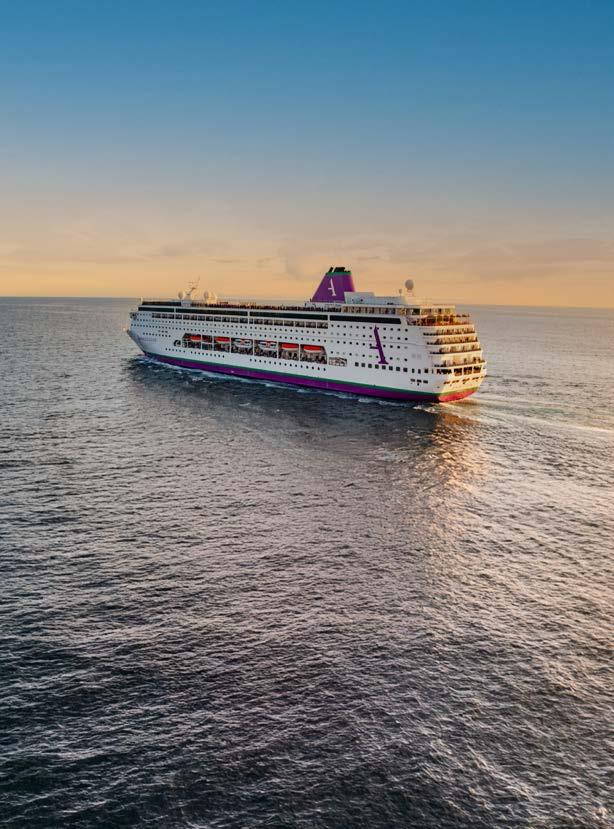


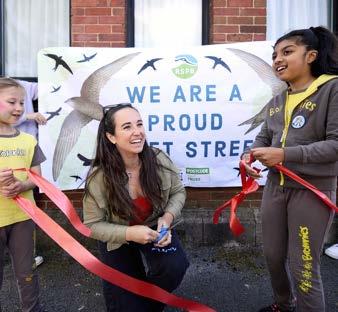
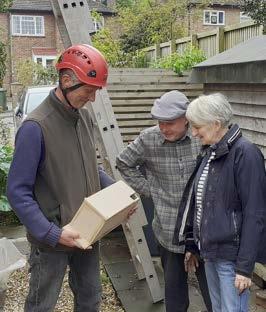
JOIN A LOCAL GROUP Meet with likeminded nature lovers and get hands-on helping nature. Visit page 82 for more details.
RSPB local groups are bringing communities together to help wildlife thrive – and building lasting friendships along the way
When communities come together for nature, remarkable things happen. RSPB local groups have raised over £25 million for conservation since 1969, and have also helped many struggling species to find a foothold in their local communities.
Few sights rival Swifts gliding across our summer skies, their calls echoing between buildings. But as nest sites in older buildings disappear, these Red-listed visitors have suffered serious declines. RSPB local groups are stepping up to raise awareness for these iconic birds.
In Bromley, Swift champion Nick Davey has spent five years working with developers and the local council to make Swift bricks a requirement in new developments. “One of my most pleasing results,” says Nick, “was getting 10 Swift bricks installed in a high-street development.”
Northern Ireland’s Antrim group has seen growing enthusiasm for Swift conservation. With support from the Save Our Wild Isles Community Fund and a dedicated Crowdfunder, the group distributed 18 boxes last year around Parkgate and nearby areas. This year, they plan to add 63 boxes in Ballyclare and surrounding villages with help from Openreach. “We hope to have more birds nesting across Antrim and Newtownabbey Borough than ever before,” says volunteer Michael Ingleston.
The local group in Solihull have been mapping Swift nests to help identify key colonies. “Last year’s survey showed two nesting colonies in Shirley and another two in Knowle,” explains volunteer Sophie Curtis.
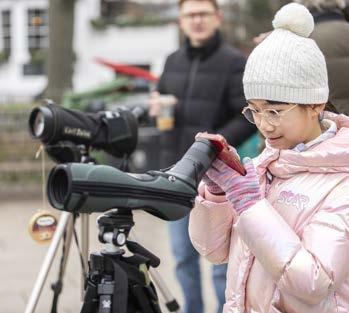
As Emma Bartlet from the Lancaster group puts it: “Swift Streets and Swift City projects have strengthened our sense of place and connection while helping us act on the biodiversity crisis locally. If you start your own project, you’ll discover many like-minded neighbours keen to get involved.”
The South East Hertfordshire group has worked closely with Affinity Water since 2019, installing Swift boxes on pumping stations and other sites across Hertfordshire and Essex. Under Affinity Water’s next five-year biodiversity plan, further conservation actions are planned, including support for Swifts, Swallows and martins, alongside Barn Owls.
In Worcester and Malvern, volunteer Simon Evans began leafletting his street in 2022, encouraging neighbours to install Swift nest boxes. With support from council grants and the Worcester Environmental Group over 150 boxes have now been installed on homes, in nearby villages and on churches, many with Swift callers fitted to attract the birds.
Homes for all
Swifts are only part of the story. Local groups support many species, often creating homes for those struggling to find them. In North Staffordshire, the group support another Red-listed species: Tree Sparrows, which suffered a severe 93% decline between 1970 and 2008. With new nest boxes, feeding stations and careful monitoring, they’re helping more chicks fledge successfully and are hoping for a third brood this season.
In Worcester and Malvern, the group supports Sand Martins along the River Severn in partnership with the Canal and River Trust. Specially designed nest boxes have helped 400 chicks fledge in a single season. “Our local group mustered plenty of volunteers to get these heavy boxes in place,” says Simon Evans. “You really get to know people through volunteering.”
Members of the Macclesfield and Stockport groups have also been surveying Willow Tits in the Peak District. In Bristol, volunteers come together for
Citizen Science Sundays, which are spent exploring green spaces and recording wildlife. These events build a picture of the city’s biodiversity and encourage people into local wild sites.
In West Cumbria, the local group supports butterfly conservation, including reintroducing the Small Blue and the endangered Marsh Fritillary. Meanwhile, at Campfield Marsh, conservation work has helped bring the Marsh Fritillary back from the brink of extinction. The butterfly has not only re-established at Campfield but also naturally spread to new areas such as Swindale Valley, offering new hope for its future.
From wellbeing walks to organising talks and fundraising events, the activities hosted by local groups go far beyond birdwatching.
In cities, the groups help people connect with nature. Each summer, many run Peregrine Watches, giving people a chance to see birds up close. York, Lincoln, St Albans and Salisbury all host watches to protect chicks. In Liverpool, a team of volunteers work shifts to safeguard chicks and talk to the public.
welcomes back Swifts to a Swift Street in Greater Manchester where local residents put up over 100 nest boxes
2. Worcester and Malvern group members overseeing the installations of nest boxes
3. Members of the public take part in the Big Garden Birdwatch with the Richmond and Twickenham Local Group
The RSPB South Wiltshire group also runs Date with Nature events at Salisbury Cathedral, sharing the wonders of these birds nesting on the tower. And there is a long history of fundraising, too. Bromley raised over £350 at the Hayes Fair, selling donated plants while chatting to visitors; North West Surrey raised more than £680 with a quiz night; and wildlife cruises run by the South Lincolnshire group raise over £2,000 each year.
Work is also carried out for local heritage and education. In Croydon, volunteers unveiled a plaque in honour of one of the RSPB’s co-founders, Eliza Phillips, while the South East Essex group hosts talks for societies to inspire with the RSPB’s work. As well as educating others, local groups are being given the opportunity to help shape local decision-making on green issues, as seen when the North East Hants group were invited to an Environmental Round Table with their MP.
Bushy Park’s wellbeing walks, run by Richmond and Twickenham group, offer a gentle way to enjoy the outdoors. “These walks are for anyone who wants to feel more connected to nature, meet new people and enjoy being outdoors,” says volunteer Debbie Williams. Whatever your interest, local groups are making a difference. Sign up at rspb.org.uk/localgroups
‘If you start your own project, you’ll discover many likeminded neighbours keen to get involved’
We’re delighted that Gola Rainforest National Park in Sierra Leone has been designated part of a newly inscribed UNESCO Natural World Heritage Site, recognising the success of conservation work led by the RSPB and partners for over 30 years. Covering 71,000 hectares, the national park is part of the Upper Guinean Rainforest, a globally important biodiversity hotspot once spanning much of West Africa. However, decades of intensive logging and the 1991–2002 civil war severely damaged this precious ecosystem.
The RSPB has worked closely with the Conservation Society of Sierra Leone and other partners to protect Gola’s remaining forest. In 2013, the RSPB helped launch a pioneering REDD+ (reducing emissions from deforestation and forest degradation in developing countries) project aimed at reducing deforestation through ranger patrols and community development initiatives. This project supports local communities by providing education, healthcare and sustainable livelihood options — including training 2,500 farmers to grow forest-friendly cocoa. You can even buy
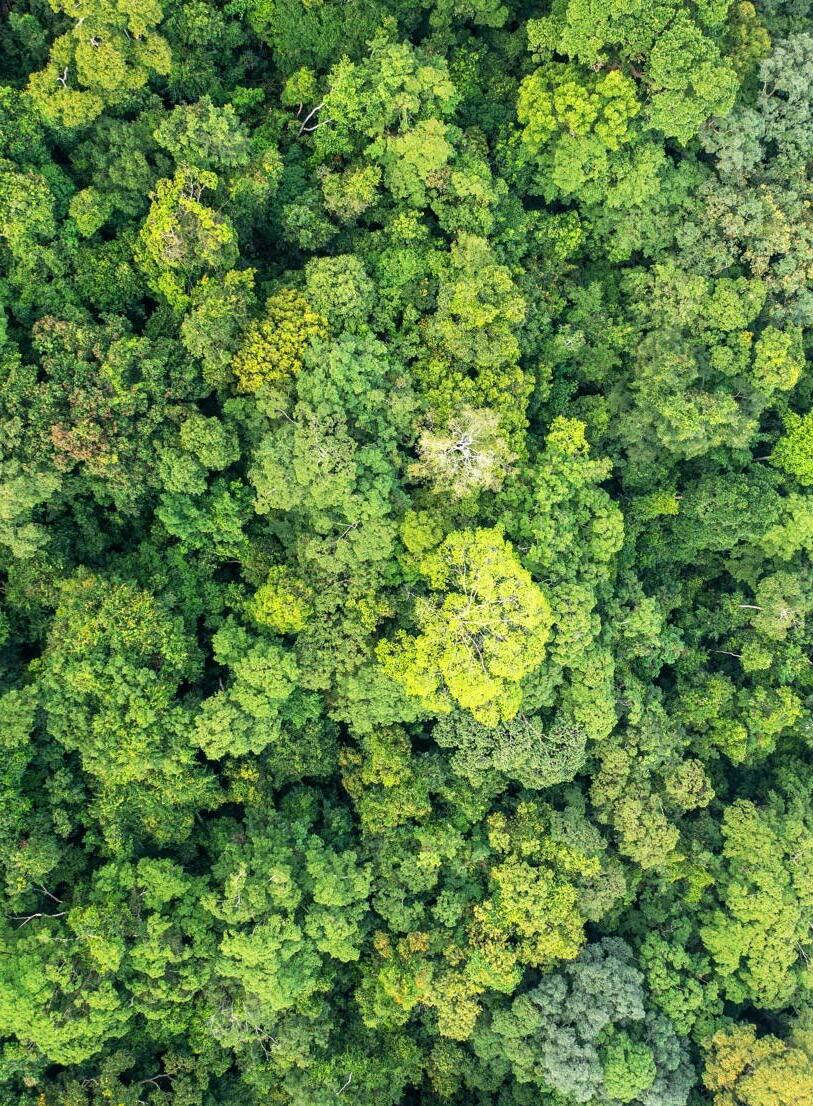
delicious chocolate made from their beans at shopping. rspb.org.uk, helping to fund ongoing conservation efforts.
The forest is home to endangered mammals such as Pygmy Hippos, pangolins, Forest Elephants and Western Chimpanzees, alongside over 320 bird species including the threatened Timneh Parrot and White-necked Picathartes (pictured).
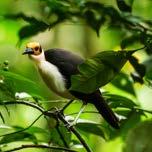
The new World Heritage status recognises the national park’s outstanding universal value for nature, together with neighbouring Tiwai Island Wildlife Sanctuary. This achievement reflects decades of dedication by the RSPB, local communities, the Environmental Foundation of Africa, the Government of Sierra Leone and other national partners. As Fomba Kanneh, Head of Gola at Gola Rainforest Conservation, says: “This is a powerful affirmation of generations of stewardship by local communities, securing a brighter future for both people and wildlife. I feel honoured and humbled to be part of this historic moment.”
Going forward, the ambition is to expand the World Heritage site to also include forests in Liberia, strengthening trans-boundary conservation of the wider Gola Landscape.
In 1965, we took on management of land near Wareham, focusing on restoring the fortunes of the Dartford Warbler – a small, elusive bird with a distinctive red eye and melodious song – after UK populations plummeted in the 1960s. A dedicated team of RSPB staff and volunteers set to work clearing non-native rhododendron scrub and pine, topping heather, and cutting back gorse to encourage new growth to provide shelter for Dartford Warblers and other species; later, conservation grazing was introduced. Over time, the reserve expanded: a former clay pit became a saline lagoon and, in 2019, Hyde’s Heath was acquired to connect habitats and reduce heathland fragmentation. Now, Dartford Warblers are flourishing.
The latest survey recorded 97 pairs, up from just two in 1965. Nightjar, Yellow Centaury, Ladybird Spider and Southern Damselfly, plus all six native UK reptile species also thrive here.



A host of species are benefiting from habitat restoration at RSPB Franchises Lodge, a 426-hectare expanse in the New Forest purchased in 2018. Ongoing work includes opening up conifer plantations and areas overwhelmed by invasive rhododendron, letting in more light to boost ground flora and fungi. Emerging native shrubs provide shelter and food, while veteran Sweet Chestnut, oak and Beech trees support invertebrates, fungi and insects.
Surveys have already recorded Pine Martens; the nationally rare Bechstein’s Bat; possibly the UK’s largest breeding colony of Common Toads; and Great Crested Newts. Birds include Lesser Spotted Woodpeckers, Firecrests and Goshawks, while butterflies such as Silverstudded Blues and Graylings thrive here, too. The species list is expected to grow as habitat recovery continues at Franchises Lodge, which is not yet open to the public.

The return of White-faced Darters to RSPB Campfield Marsh marks an exciting milestone for dragonfly conservation. Numbers of this small but striking dragonfly have plummeted in England due to habitat destruction.
Over many years, conservationists have worked to create the right habitat conditions at RSPB Campfield Marsh in Cumbria for this ambitious translocation, led by the RSPB, with advice and support from the British Dragonfly Society, Cumbria Wildlife Trust and Natural England. In April and August, staff and volunteers carefully collected small amounts of Sphagnum moss containing larvae of one of our rarest species, the White-faced Darter, from a stable donor population, transporting it in buckets to healthy peatbog at Campfield Marsh. And in July, Campfield Marsh was officially designated a Dragonfly Hotspot – the 12th such location in England, recognising its role in conservation.

Thousands of nature-lovers showed the power of direct engagement with MPs at the Act Now, Change Forever Mass Lobby in Westminster on 9 July.
Political action is urgently needed to deal with huge challenges facing nature across the UK. These include potential threats to wildlife sites posed by inappropriate development, and levels of investment in nature-friendly farming that fall short of what’s needed – issues that impact communities and farmers’ livelihoods, as well as exacerbating the nature and climate crises.
A year after the Restore Nature Now march, these issues still loom large. So we’re proud that hundreds of our supporters joined the Mass Lobby, organised by The Climate Coalition and supported by the RSPB and other NGOs.

Many spoke directly to their MPs for the first time, spurring some of those representatives to pledge to take their constituents’ concerns to Parliament, and to push for stronger protections for wildlife. Dozens of people also shared their aspirations for change on our Wings of Hope installation during the day.
Read Alice Hardiman’s interview on page 14 to learn how writing to your MP really can make a difference. Visit writetothem.com to add your voice.
The RSPB’s capacity to monitor Choughs in North Wales has been strengthened this year with the recruitment of nine dedicated volunteers. Each has been assigned a nest site to visit regularly across the breeding season, recording key data on nesting success, hatchlings and fledglings. The scheme – part of the Natur am Byth! partnership to save Wales’ threatened species – is already proving a great success.

CORRECTION:
In the Spring/Summer 2025 issue of The RSPB Magazine we said that Rathlin Island is between Scotland and Ireland. We should have written ‘geographically situated between Scotland and Northern Ireland’. Thanks to the reader who spotted this.

1,100
rot holes created in dead wood for the benefit of Pine Hoverfly
25
In 2024, a record 39 Smooth Snakes were recorded on the Pebblebed Heaths NNR in east Devon. Between 2009 and 2010, 17 of these non-venomous snakes were released by the RSPB, Amphibian and Reptile Conservation and Pebblebed Heaths Conservation Trust. The UK’s rarest reptile, which had vanished over the last 50 years, is now self-sustaining and expanding across east Devon.
The rare Pine Hoverfly is the focus of a new conservation strategy involving the RSPB. Critically Endangered in the UK, the species depends on old-growth Scots Pine and flowering understory trees and plants. Its larvae develop in water-filled rot holes where bacterial ‘soup’ created by fungi provides essential nutrients. A flagship species for Caledonian pine forest, the Pine Hoverfly is also an important pollinator and recycler. It’s a priority for the Rare Invertebrates in the Cairngorms project, a partnership including the RSPB, Buglife, Butterfly Conservation, Cairngorms National Park Authority, NatureScot and Royal Zoological Society of Scotland.
Over the next five years, the RSPB and partners will continue habitat creation, monitoring, research, releases and campaigning to support this species.
21,181
Pine Hoverflies released to date
30
volunteers who spent six weeks preparing larvae for release and surveying habitat for signs of successful wild breeding

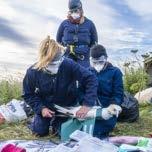
Highly Pathogenic Avian Influenza (HPAI) continues to affect UK birds. Since HPAI was detected among Great Skuas in Scotland in 2021, it’s killed tens of thousands of birds in the UK. Worryingly, it’s still circulating and there is growing evidence for impacts on birds of prey.
The RSPB is working to mitigate the impacts of outbreaks and promote the recovery of affected populations. Across our nature reserves, staff contribute to large-scale surveillance by reporting dead birds and collecting samples for testing. We also work with all four country governments and other conservation bodies to ensure national response plans yield the best outcomes.
The RSPB’s Wildlife Disease Fund (rspb.org.uk/donate/focus-on-theirfuture) continues to support our largescale research, enabling us to respond to outbreaks on RSPB reserves and to push for action from governments, including addressing the threats wild birds face.
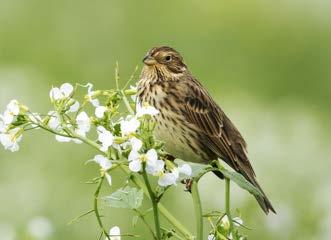
A new study by RSPB conservation scientists suggests improvements that could benefit Corn Buntings (pictured) in north-east Scotland. Once widespread, Corn Bunting numbers in eastern Scotland fell by 83% between 1989 and 2007. Corn Buntings are late breeders and nest on the ground. In north-east Scotland, they often nest in silage fields where many eggs and chicks are destroyed by summer mowing. A Scottish Agri-Environment Climate
Read a longer piece on Corn Buntings online when you switch to digital membership. rspb.org.uk/gopaperless
Scheme (AECS) option compensates some farmers for delaying harvest, but this isn’t widely taken up. Now, new findings show that autumn-sown green manure not only improves soil health but also significantly boosts Corn Bunting nest survival.
The RSPB is calling for a new AECS option supporting autumn-sown green manure alongside late mowing, which could encourage more farmers to take action for Corn Bunting in key areas.
CONNECTED: Another way your support is helping farmland birds is through the RSPB’s Hope Farm, which trials and demonstrates nature-friendly farming methods. Simon Barnes visited as part of the farm’s 25th birthday celebrations (see p25).

A programme of monthly conservation activities is attracting students at Bangor University in North Wales. Dubbed RSPB Flight Club by its three coordinators, the project has seen participants monitoring Chough nests and analysing trail-camera footage. The collaboration aims to provide real-world conservation experience, boosting employment prospects and encouraging long-term volunteering.

An exciting partnership between the RSPB and Openreach has boosted nesting opportunities for birds and bats in England and Northern Ireland, achieving impressive milestones in its first year.
Openreach engineers, alongside volunteers from RSPB local groups, utilised their expertise and mobile elevating work platforms (cherry pickers) to install over 50 nest boxes. It is hoped these efforts will provide safe havens for Red-listed species such as Swifts, House Martins and House Sparrows, across the Forest of Bowland, the West Midlands and Northern Ireland, with more areas still to benefit. Community engagement has been key, with local communities
We’re celebrating three decades of peatland restoration, research and biodiversity conservation at RSPB Forsinard Flows in Scotland. Since 1995, staff and volunteers have protected and enhanced the site, now expanded to more than 21,000 hectares of blanket bog, farmland, and riparian and freshwater habitats. It’s home to Golden Plovers, Greenshanks, Hen Harriers, Skylarks, Red- and Blackthroated Divers, reptiles, amphibians, dragonflies and rare plants. It’s also a hub for community engagement and education.
CONNECTED: Restoring peatland for wildlife helps to capture carbon to tackle the climate crisis. More on p29.
allowing nest boxes at their homes and businesses, enhancing biodiversity and fostering a connection to nature.
This project is part of the broader Openreach-RSPB Business Conservation Partnership, launched in July 2024. The collaboration also involves the RSPB supporting Openreach in developing a Nature Positive business strategy. This includes identifying opportunities for the workforce to engage with nature and offering ecological advice to ensure that Openreach’s Full Fibre build plan has minimal impact on natural environments.
The Openreach-RSPB partnership is a great example of how business and nature can thrive together.
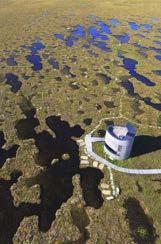
Recent camera-trap images from Hutan Harapan in Sumatra, Indonesia, showcase a thriving ecosystem. This vast stretch of lowland rainforest is co-managed by the RSPB and partners.
Among the highlights is the critically endangered Sumatran Tiger, a keystone predator requiring large, undisturbed forest and a stable prey base, including the Bearded Pig.
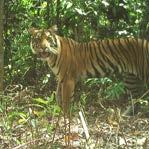
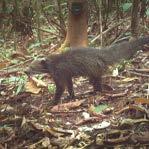

A rare sighting of a fruit-eating Binturong (also known as a Bearcat) points to an abundance of fruiting trees. Meanwhile, ground-dwelling birds, Malayan Crested Fireback and Great Argus, thrive in dense undergrowth and undisturbed forest floor. These camera captures indicate a healthy rainforest ecosystem. Since 2007, the RSPB has worked with BirdLife International, Burung Indonesia, NABU, and PT REKI to protect and restore this important ecosystem.





















Please quote code 25BIRDS4 on our website, by ‘phone or return coupon to: FREEPOST RTCK-ZKYJ-GGRB, Fife Country, Cupar, Fife KY15 4RB
■ I enclose a cheque made payable to Fife Country
■ Please charge £________ from my credit/debit card





































The superior thermal properties of its soft ‘micro-fleece’ makes this Fife Country shirt as warm as toast. Light and less bulky than a jumper it won’t weigh you down. Its wicking properties take moisture away from your body and help keep you dry. Soft against your skin yet comfortable over a t-shirt. In a quick dry, easy-care fabric it is practical too, with a 7 button front, zipped breast pocket, cuff adjuster and long shirt tail to keep the draft out. Perfect as an overshirt. All this and FREE Delivery. Order today and keep warm in our best selling fleece shirt.
Thank you for your order. If you DO NOT wish to receive offers from carefully selected companies* please tick the box *Please see our full privacy policy at www.fifecountry.co.uk Company Reg No 15281 Trusted for over 136 Years
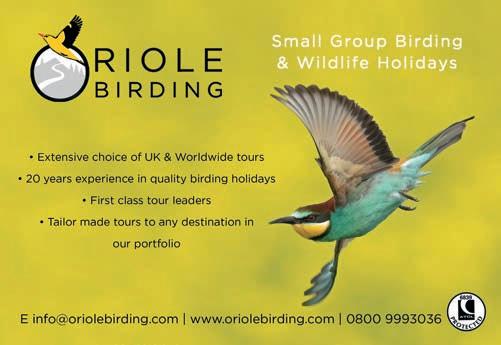
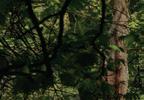
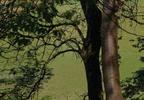

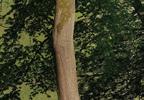




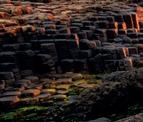


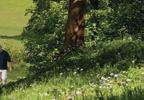



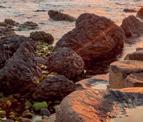





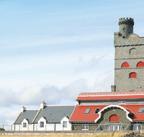

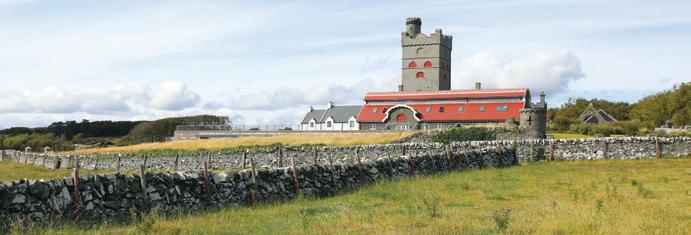
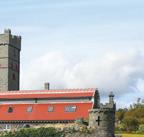
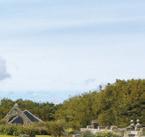











Imagine being able to enjoy fantastic holidays in these beautiful locations. That’s exactly what over 40,000 discerning holidaymakers have already done.
The Holiday Property Bond’s portfolio currently includes more than1,500 holiday homes in over 30 exclusive UK and European destinations. Discover this refreshing new approach to the way you plan and enjoy your holidays. You can even pass the benefits on to your children and grandchildren so they will have a lifetime of wonderful holidays to look forward to.




Become a Bondholder with HPB and you could take your pick from a range of beautiful locations with breathtaking scenery right on your doorstep, every year for life.



It’s never been easier to find out more about the Holiday Property Bond for yourself, free and without obligation.





I am pleased to report on the annual accounts for 2024–25. We are restoring nature on a truly significant scale with world-leading conservation on our reserves and through the strength of our policy, campaigning and science work. Our role is to ensure that we use our resources – your generosity and ongoing support – with maximum impact. Everything we do is focused on delivering the greatest outcomes for nature and we continue to ensure that we do so both effectively and efficiently.
Therefore, I am happy to present the headlines from our accounts below.
Good income growth of £25.1 million to a record £195.0 million, with total expenditure rising by £8.8 million to £176.8 million. Together with a £0.6 million rise in investments, this has resulted in net income of £18.8 million for the year. Total financial reserves rose by £29.9 million reflecting net income of £18.8 million and a £11.1 million actuarial gain in respect of the defined benefit pension scheme liability due to changes in the wider economic environment.
The £18.8 million surplus is mainly because of increases in restricted funds. Firstly, where we have received income and spent it in the year on acquisitions, including £6.7 million additions to our nature reserves at Geltsdale and Wallasea from legacy and trust income. Secondly, where we have received income to be spent on specific activities in the future, including £4.9 million received from the Omaze deal which will fund much-needed work to restore our peatlands.
Free Financial Reserves decreased, less than planned, by £1.7 million to £40.3 million and represents 12 weeks’ total expenditure cover, which is at the midpoint of the 8 to 16 week Reserves Policy set by Council.
Like all organisations, in every sector, the uncertain financial and external context has led to higher running costs. External volatility looks here to stay, and while we remain financially resilient, we must continue with strong financial management to maintain our financial sustainability for the future.
As always, the foundations of our financial strength are the support and commitment of our members, supporters and funders, which has been stronger than ever across the financial year and for which we are always grateful. With this support, we will continue to drive the delivery of our strategy to meet the ongoing challenges of the nature and climate emergency both in the UK and internationally.
These summarised financial statements are extracted from the full statutory trustees’ annual report and financial statements, which were approved by the trustees and signed on their behalf. The full financial statements, on which the auditors Crowe UK LLP gave an unqualified audit report in August 2025, are available on our website within our annual report: rspb.org.uk/ annualreport
The auditors have confirmed to the trustees that, in their opinion, the summarised financial statements are consistent with the full financial statements for the year ended 31 March 2025. These summarised financial statements may not contain sufficient information to gain a complete understanding of the financial affairs of the charity. The full statutory trustees’ report, financial statements and auditors’ report may be obtained from the website. Signed on behalf of the trustees.

Sir Andrew Cahn Chair, RSPB Council
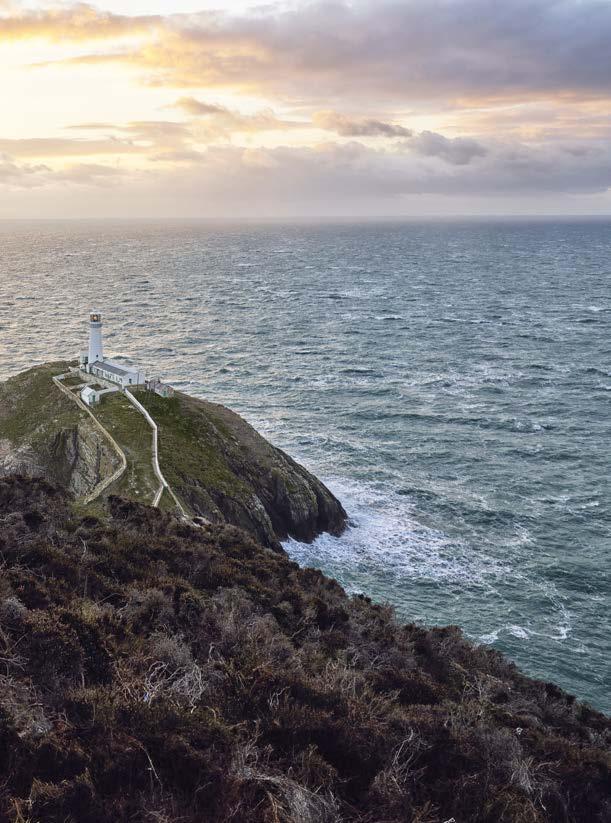
Days out in nature
In autumn and winter, RSPB nature reserves are not just wondrous places teeming with wildlife, they’re also vital refuges for nature. Ann Favell takes a bird’s-eye view
This far-flung site is a magical mix of coastal heathland, grasslands and spectacular cliffs. Located on Anglesey in North Wales, and perched high on a cliff, its windswept landscape with panoramic views, which include a lighthouse and a Victorian folly, has been inspiring visitors since the RSPB began managing the site in 1977.
Choughs are a highlight species to see. At this time of year, it is possible to spot flocks of 20 or more across the nature reserve foraging for food. The bird’s Welsh name, Brân Goesgoch, translates to red-legged crow, an apt name given the bird’s distinctive bright red legs. Choughs are the rarest member of the crow family in the UK.
Look up as you move along the clifftop walks and you may see Ravens and Peregrines flying by on the coastal breeze. Look down and you might catch a glimpse of seal pups nestled in coves. There are also Herring Gulls, Lesser Black-backed Gulls, Great Black-backed Gulls and sometimes the occasional Guillemot perched on the cliff. Look out to the Irish Sea and you may be lucky enough to see Harbour Porpoises, Grey Seals or dolphins.
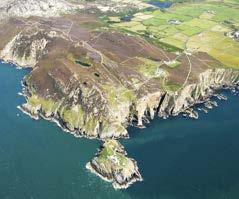

Opposite: The rugged coastline of South Stack is famous for its lighthouse
1. South Stack sits at the northerly tip of Anglesey
2. Chough are a star species at this site
3. You may see Grey Seals offshore or hauled out on the rocks, be sure not to disturb them
This season is a busy time for staff and volunteers as the site’s ‘woolly mowers’, aka Hebridean and Manx Sheep, are put out to graze the heathland to keep it healthy and under control. Small areas of heather and gorse are removed on rotation to allow flowering plants to bloom the following year – this is vital to support the Silver-studded Blue butterfly populations during warmer months.
But those more temperate months are some way off, and the clifftop winds can be bracing. So, round off your visit with a late afternoon stop at the café, where stunning sunsets across the Irish Sea can be viewed while cupping a very welcome warm drink in your hands.
There are also a wealth of winter events going on at South Stack. Go online or see page 10 for more.

Getting there
The reserve is 3 miles from Holyhead, which has the closest train station.
National Cycle Route 8 also goes to Holyhead.
Accessibility
Parking: Two car parks with 10 Blue
Badge spaces.
Wheelchairs: There is access to Ellin’s Tower and the viewpoint beside it. The visitor centre has a disabled toilet. Dogs: Dogs welcome on leads.

Home to the RSPB HQ, this site boasts a mix of established woodland, heathland and grasslands, plus some bare sand areas, farmland and gardens that are home to a vast array of species – 5,537 at last count!
When purchased in 1961, The Lodge buildings in Bedfordshire came with 42 hectares of land. Since then, it has expanded to 220 hectares, which now encompass some historical features including an Iron Age hillfort dating back to 500 BC.
Autumn into winter is a particularly good time to visit. Soak in the quiet stillness of nature as you enjoy six miles of nature trails. During autumn, the woodland vibrates with colour, with various shades of gold, red, orange and brown. Keep an eye out in October as some of the 763 species of fungi found here put on their annual show.
In the woodlands, when trees are bare, you may spot a Treecreeper making its way up tree trunks to forage for food. Nuthatches and Jays can be seen, with the former stashing seeds into cracks in bark or crevices to feed on later when needed, and the latter doing likewise but most often burying their cache in the ground. You may spot the resident Ravens, the largest of the crow family.
Overwintering thrushes, including Redwings and Fieldfares, can be seen working their way across the site in search of berries and seeds. Flocks of finches including Siskins, Lesser Redpolls and occasionally Bramblings can also be seen on the hunt for seeds.


4. Sunrise comes to the peaceful woodlands of The Lodge
5. Redwings and other migrant birds visit in winter
6. Fly Agaric is just one of the fungi species found here
It’s at this time of year that staff and volunteers carry out work to maintain the heathland; a rare habitat in this area, which was much expanded over the last 20 years. Birch saplings are removed to stop them shading out the heather, which is intermittently mowed to encourage new growth and provide the habitat loved by Natterjack Toads and Woodlarks. This annual management ensures that the heathland stays in top condition and thrives for many years to come.
Getting there
Just one mile from Sandy train station. National Cycle Route 12 goes to Sandy.
Accessibility
Parking: The two car parks have a combined 70 spaces, eight of which are Blue Badge.
Wheelchairs: The path from the visitor centre to the house and around the gardens is accessible. Accessible toilets are available. Dogs: on leads on Skylark trail only.
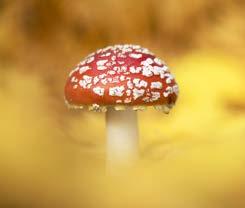

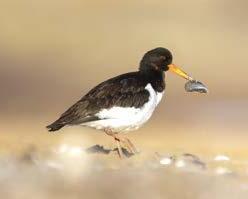

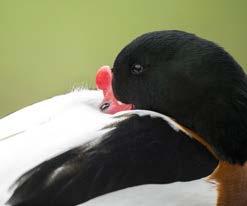
Nestled amongst a busy industrial landscape with distant views across Belfast’s docks, you’ll find the Belfast Window on Wildlife nature reserve (or Belfast WoW for short). It’s unusual name stems from the panoramic viewing windows that greet you upon arrival in the visitor centre, providing a warm spot to view wildlife on the wetland lagoon.
The original idea was to establish a haven for wildlife and offer visitors, both local and from further afield, a place to connect with a diverse range of birds and other wildlife in an urban landscape.
Pop into a hide during winter and you are likely to be in for a real treat. Belfast WoW provides the last high tide roost before the Irish Sea for this area of coastline, so is an important place for migrating wildfowl and wetland species. In previous winters bird numbers have peaked at around 300 Curlew, 200 Shelduck, 450 Oystercatchers, 500 Black-tailed Godwits and 250 Teal. The site also provides a migratory stopping point for wintering passerines such as Reed Buntings and Linnets to rest and refuel.
Resident species such as Shelduck, Lapwing and Redshank can be seen and Konik Ponies, able to live on wet grassland, graze around the artificial lagoon, helping to maintain and create suitable habitat condition for wintering wildfowl.
Winter months bring a flurry of human activity as areas of reedbed and Sea Club-rush are cut to keep it under control and maintain open water favoured by wildfowl. Cutting also allows species to have access to the water’s edge where they can forage. The tern breeding raft receives annual maintenance to ready it for the following year when tern species, including Arctic, Common and Sandwich Terns (which bred here for the first time in 2025) will return.
This site is as unexpected as it is welcome in such an urban setting and definitely worth a visit during the colder months. It offers an escape from the city for visitors and a vital refuge for wildlife.
7. Watch Oystercatchers probe the mud for their supper
8. Just outside Belfast, this site is an urban oasis
9. Shelducks can be seen here in winter
13 car parking spaces, with

Spanning 237 hectares – just over 382 football pitches – this thriving wildlife haven has been in RSPB care since 2012. Travelling along the hedgerow-lined entrance, a small visitor building with a friendly team of staff and volunteers is there to greet you. From here, you can visit the dramatic ‘Skein Dial’ sculpture –representing the long journey many species of geese have made to and from this site during migration. Indeed, it is an important site for wintering geese in October as approximately 1.3% of the global population of Greenland White-fronted Geese arrive from Iceland, alongside thousands of Pink-footed Geese (making RSPB Loch Lomond internationally important for both species each winter) and hundreds of Greylag Geese. They are joined by Whooper Swans, and flocks of wildfowl including Teals, Tufted Ducks and Wigeons.
This site contains an interesting mix of different habitats including wetland, fen, woodland and various grasslands. These host a broad range of biodiversity, with 120 plant species including the endemic Scottish Dock, and other species such as Red Squirrel, Otter, Badger and Lapwing. Walk the 1.5km Airey Trail to travel through coppiced Alder woodland, meadow, fen and ancient oak woodlands to reach the breathtaking shores of the famous loch.
Mid-autumn marks the start of goose monitoring work. This includes weekly checks of key feeding areas and dawn roost monitoring surveys to keep an annual record of the number of visiting geese and breeding successes. Essential maintenance is carried out on sluices that help balance water levels within the floodplain, and fencing is maintained. Active management, such as autumn cutting, provides open areas for wintering wildfowl to feed and roost.
RSPB Loch Lomond delivers with wildlife in abundance. Combine this with the dramatic scenery of the loch, distant snow-capped mountains and accessible walks, and it makes for a great day out.
10. Listen to the hoarse honking and cackling of Greylags 11. Loch Lomond sits within the Loch Lomond and The Trossachs National Park
12. Watch Red Squirrels caching food for the colder months ahead

Communications Officer Ann Favell has worked for the RSPB and The Wildlife Trusts.
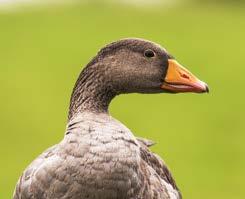
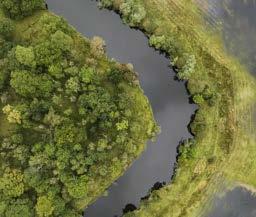

Getting there
Around 20 miles from Glasgow, the reserve is half an hour by bus from Balloch train station. National Cycle Route 7 comes within 2 miles.
Accessibility
Parking: 15 car parking spaces, with
one Blue Badge space. Wheelchairs: The trails have a hardcore surface. Picnic benches and one portaloo toilet are accessible. Dogs: Dogs are welcome.



Our lightweight insulated panels make your conservatory warmer in winter, cooler in summer, will help to reduce bills, and are quieter in bad weather. To find out more about the benefits that the Green Space system can offer and see if your conservatory is suitable for any potential subsidies, contact us today for a FREE NO-OBLIGATION quote.

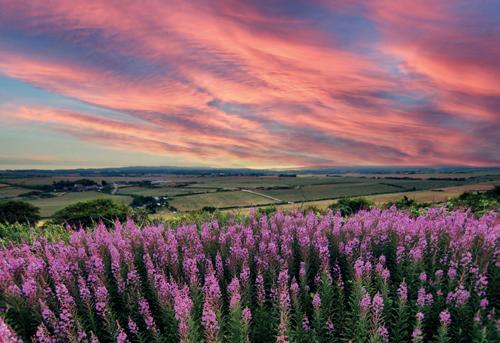




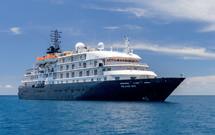
An exploration of the land of fire & ice aboard the MS Island Sky 15th January to 1st February 2027

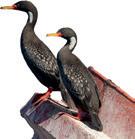
Those who have a passion for the wilder places on our planet usually have Patagonia on their must do list. Shaped by fire and ice, this rugged, yet hauntingly beautiful land of windswept pampas, hanging glaciers and cloud piercing peaks, remains today as enticing and fascinating as it did to Magellan, Drake and more latterly Darwin.
Chile is made for cruising. Its shape and geographic location is just perfect; thousands of miles of coastline that you can of course explore aboard one of the many huge cruise vessels calling at the major cities of South America or alternatively join us aboard the 118-passenger MS Island Sky and enjoy the wonders of this magical country, some of which only small ships have access to. Wildlife abounds here and the skies are filled with the cries of seabirds. Albatross’ and petrels’ wheel overhead and sea lions bark from their rocky outcrops. Helping us understand all the wonders we will encounter will be our experts and expedition staff who will accompany us ashore and our small ship will allow us to enter small inlets and explore fjords and stretches of magnificent coastline.
MS ISLAND SKY is one of the finest small ships in the world. With a maximum passenger capacity of only 118, the all-suite vessel has the benefit of unusually large accommodation, public areas and spacious outside decks. All suites feature a sitting area and some have a private balcony. The spacious and finely decorated public rooms include a lounge, elegant bar, library and a single seating dining room. Outside there is a rear sun deck, a bar and comfortable deck furniture. The atmosphere on board is akin to a private yacht or country hotel. A little music in the lounge or bar after dinner, talks from the onboard speakers, informative port briefings and of course good food which may be enjoyed leisurely in the attractive dining room, all contribute to making any voyage aboard the MS Island Sky a memorable experience.

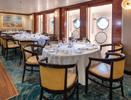

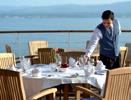


Please note that flexibility is key to a successful expedition. Although we have outlined an itinerary below, this is only a preliminary plan, our exact route and landings will depend on weather conditions, tides and the wildlife we encounter.
Day 1 London to Buenos Aires, Argentina. Fly by scheduled flight.
Day 2 Buenos Aires. Arrive and transfer to our centrally located hotel for an overnight stay. This afternoon is free to relax in the hotel or maybe join an orientation tour of the city including the Plaza de Mayo, the Cathedral and the Cabildo (Old City Hall). Our tour will end in La Boca for the opportunity to look around the colourful zinc houses which used to be the refuge and home for the first immigrants and popular artists.
Day 3 Buenos Aires to Ushuaia. After breakfast in the hotel we will transfer to the airport for our scheduled flight to Ushuaia. On arrival we will transfer to the MS Island Sky and will start our adventure this evening as we cruise down the Beagle Channel. Here the mountains, still partly unmapped, drop as sheer, densely wooded cliffs into the channel and penguins, dolphins and South American sea lions abound in the channel.
Day 4 Cape Horn. At dawn we arrive at Cape Horn, one of the best known maritime landmarks in the world. Magellan was the first European visitor here in 1530 and prior to the opening of the Panama Canal it was an important staging post. Weather permitting, we hope to use our Zodiacs to land and enjoy a walk to the monument. After lunch we continue our journey along the Chilean coast and into the fjords.
Days 5 to 11 Chilean Fjords & Torres del Paine National Park. During the next seven days we will enjoy some of the most stunning scenery imaginable and the MS Island Sky is the perfect vessel for the exploratory and scenic cruising that we will be undertaking. This vast area of mountains, glaciers, islands, lakes and waterfalls is untouched by man except for a few fishing villages which perch at ‘the end of the world’. We will make good use of our time exploring the beautiful, protected waters, enjoying the renowned fjords of southern Chile which rival those of southeast
Alaska in their raw beauty and prolific wildlife. Our route will be managed by our experienced Captain and Expedition Leader alongside the local pilots. As well as stunning scenic cruising, the area is ideal for Zodiac forays. As we continue our journey we hope to navigate the White Narrows, a remarkable channel just 260 feet wide with dramatic cliffs and crystal clear waters. Dropping anchor at Puerto Natales, we enjoy a full day in South America’s largest national park, the Torres del Paine. This is one of the most spectacular places on earth, a vast uninhabited wilderness of glacier-draped mountains, windswept pampas, turquoise glacial lakes and verdant valleys. Look out for herds of guanacos (a smaller version of the llama), rheas, Patagonian hares, foxes and rich birdlife and see the stunning rock formations of the Horns of Paine. We also hope to operate Zodiac excursions ashore in some of the remote fjords we pass on our journey.
Day 12 Chiloe Island. Chile’s second largest island, Chiloe Island was one of the first Spanish strongholds in the Pacific Southern South America. Once the island had been conquered, it was hard for indigenous uprisings to reconquer and as a result it became a major link in the Spanish trade route around Cape Horn. The island was also visited by Darwin aboard the HMS Beagle in 1831. Our visit ashore on this mainly forested island will include Castro, one of the oldest towns in the Americas, known for its unique wooden architecture, churches and stilted houses.
Day 13 Puerto Montt. Over breakfast we land at picturesque Puerto Montt, a resort town in the Lake District. Settled by German colonists in the mid-19th century, much of its early MiddleEuropean styled architecture remains, rendering a slightly bizarre feel in such an obviously unEuropean setting. Leaving the ship we will head to the Vincente Perez Rosales National Park which is the oldest in Chile and contains three commanding volcanoes in Osorno, Calbuco and Puntiagudo. We will see the emerald Todos los Santos Lake at the foot of Mount Osorno as well as the mighty Petrohue River and the rapids that crash through lava channels creating a series of magnificent waterfalls. We return to the ship via Puerto Varas, situated in a stunning location on Lago Llanquihue with a backdrop of the iconic Osorno volcano.


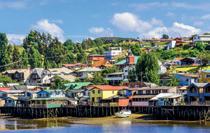
Day 14 Valdivia. From the port of Niebla, this morning’s tour takes us to the colonial city of Valdivia, one of the oldest European settlements in Chile. Our guided excursion will include time at the Canelos Tower, built in 1774 and which at the time of its construction was one of only two land entrances to the city, equipped with a wide portcullis and drawbridge. We will see the San Francisco Church before spending some time exploring the historical and anthropological museum and the bustling Mercado Fluvial.
Day 15 At Sea. Enjoy a day at sea as we continue our journey north.
Day 16 San Antonio to Santiago. Disembark after breakfast and drive out to the Casablanca Valley which is now one of the country’s premier wine areas. We will learn about the cultivation of grapes during a visit to one of the vineyards for a tasting and lunch. In the late afternoon we will arrive at our hotel in Santiago for an overnight stay with the remainder of the day at leisure.
Day 17 Santiago to London. Check out this morning and transfer to the airport for our scheduled flight to London.
Day 18 London. Arrive today.
Special offer prices per person based on double occupancy start from £9995 for a Standard Suite.
Economy class scheduled air travel • Overnight hotel accommodation in Buenos Aires & Santiago with breakfast • 13 nights aboard the MS Island Sky on a full board basis • House wine, beer and soft drinks with lunch and dinner • Noble Caledonia expedition team • Shore excursions • Gratuities • Transfers • Airport taxes • Port taxes. NB. Ports and itinerary are subject to change. All special offers are subject to availability. Travel insurance, dinner on day 2 and day 16 are not included in the price. Zodiacs will be used during this expedition. Our current booking conditions apply to all reservations.
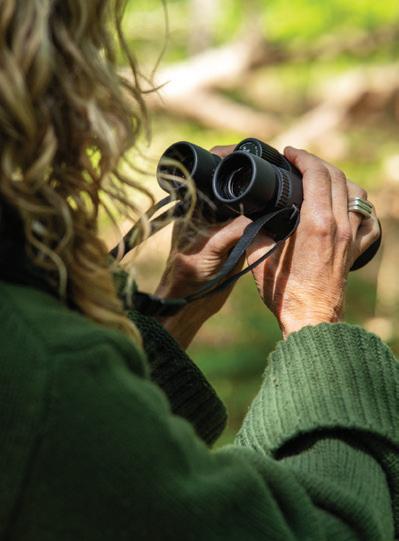







New for 2025, the RSPB Skylark® is a fantastic starter binocular for budding nature enthusiasts at the beginning of their birdwatching journey. It offers superb clarity and image quality, as well as great value for money. The ergonomic and lightweight design makes it a perfect


Get closer to nature with RSPB’s range of binoculars and scopes.

Looking for a Christmas present? Don’t forget to join us at our Demo Weekend from 29-30 November to try a range of binoculars and scopes for yourself and get expert advice. You’ll receive double loyalty points for every optics purchase.
Find your nearest participating nature reserve at shopping.rspb.org.uk/store-finder

level viewing with a range of imageenhancing technologies. Extra-low dispersion glass, phase correction, and dielectric-coated prisms all work together to provide a bright, crystalclear, true-to-colour image. The impressive field of view makes it easy to find and keep fast-moving birds in sight, so you’ll never miss a thing!


Introducing the RSPB’s flagship model: the Sparrowhawk®. Experience unprecedented visibility and image clarity. High-performance phase-coated and SHR-coated prisms, combined with field-flattening ED lenses, virtually eliminate chromatic aberration and colour fringing. See nature like never before - even in low-light conditions. Thanks to their lightweight magnesium body, you’ll never want to put them down!

I love animals, and I’m worried about the impacts of climate change on humans and nature. This is why I decided to start fundraising for nature.
I began when I was eight years old. First I did litter picking, then I wanted to do bigger challenges. I walked the 102-mile Cotswold Way, and then I climbed more than 10 mountains in 10 days and walked the 100-mile Three Choirs Way.
This year, I climbed over 100 mountains in 25 days and have climbed most peaks in Wales. I then went on to complete the 160-mile Camino Portugués from Porto in Portugal to Santiago de Compostela in Spain. I also completed a Snowdonia Triathlon, which involved cycling 40 miles, canoeing and climbing Snowdon.
My favourite challenge so far has been completing 100 mountains because I love climbing mountains! I also like talking all the way, especially about Warhammer. The Camino Ingles (approximately 115 miles) was also very fun. I met lots of people, including a lady called Carmen who ran a café – she was so excited to see a young boy walking the Camino she gave me a hug! That was also such a special challenge to finish as the finish line is at Santiago de Compostela’s cathedral.
For me the toughest challenge has been the Snowdonia Triathlon, but I did it with my friends Harry and Dexter and that made it a lot more fun.
I am currently working on my next challenge – walking the 177-mile Offa’s Dyke Path, spanning the length of the English/Welsh border. After that I would like to climb 1,000 mountains in 333 days. This will be three mountains a day!
The thousands of pounds I have raised have gone to charities such as the World Land Trust, The Outdoor Guide Foundation and the RSPB. I feel very proud of everything I’ve achieved. This type of fundraising is lots of fun: you get to go outdoors and help nature at the same time.
Jack
SUPPORT JACK You can sponsor Jack’s latest incredible challenge through his ongoing RSPB fundraising page at justgiving.com/page/ jacksfundraising forwildlife
Star letter
As the skipper of a passenger boat on the Manchester Ship Canal and River Orwell, I’m often asked: “How polluted is the river these days?” Growing up in the ’60s and ’70s, my teachers used to say it would take centuries to clean up the waterways – even if industrial and sewage pollution were halted overnight. But the explosion in wildlife and the growing variety of species have proven this prediction wrong. Now in my third year working on this canal – approaching 50 years of navigating Britain’s waterways – I’ve witnessed first-hand the dramatic recovery of the rivers. The abundance and diversity of birdlife, in particular, are clear signs that the waterway is not only recovering, but thriving.
Although I don’t consider myself an expert, I keep a personal list of the bird species I’ve seen here. That list has
just reached 50 in the last three years. Sand Martins nest between the coping stones of the former Pomona Dock, an area earmarked for development. A new regular visitor there is a single Little Egret, frequently seen on a nearby sandbank. Kingfishers are spotted often – usually in pairs.
Recent newcomers include Peregrine Falcons, which appear to have settled near one of the BBC buildings. Among the hundreds of Canada Geese, we also have a solitary Greylag Goose that stands out.
The influx of Cormorants into inland waterways over the past 20 to 30 years has been fascinating, and this part of Manchester is no exception. Some Cormorants have even learned to swim ahead of our boats, catching the fish we stir up. I’m no expert on fish species, but the ones I’ve seen caught

The star letter wins a pair of RSPB 8x32 Avocet binoculars from our Viking Optical range –waterproof, nitrogen-filled and robust. To see the full range, visit rspbshop.co.uk
– by Grey Herons, the Little Egret and Kingfishers –suggest the water is now well-stocked.
Each evening, hundreds of gulls gather on the broader sections of the old docks. They stick to their own flocks: Lesser and Greater Blackbacked, Herring, Black-headed, and occasionally Yellow-legged.
One of the favourites among birdwatchers are the Goosanders. They form a ‘raft’ and dive in formation as boats pass by. This flock of juveniles (pictured) seems to have found a roost on the disused Victorian steps of Pomona Island. The MediaCity area is proving that wildlife watching in a city centre can be just as exhilarating as in any countryside or coastal location –especially in places like this, accessible only by boat.
John Stirzaker
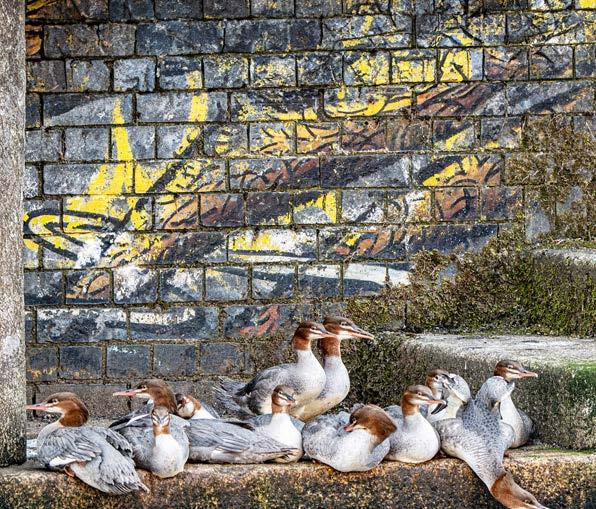
Bittern by the bug
We’ve all heard of the runner’s high, and I was pretty full of endorphins after competing my 31st Parkrun at the Millennium Country Parkrun, Forest of Marston Vale. After getting my breath back, I pointed out to the runner next to me how lucky we were to hear the Turtle Dove calling from the trees behind us. As we looked up, a Bittern flew straight over our heads. As I had only ever seen

one before about 30 years ago at Cley Marshes, this was a real bit of luck and a great way to combine hobbies!
Neil Coles
of hope
Thank you so much for the article in the latest magazine on the return of the White-tailed Eagle. What an amazing success story down to the hard work and dedication of so many people, but
especially Dave Sexton. I went on a birdwatching holiday on the Isle of Mull in 2006 and was fortunate enough to see the eagles on several occasions. What magnificent birds – totally aweinspiring. I now live at the foot of the South Downs in East Hampshire and eagles from the Isle of Wight have been seen soaring above Butser Hill just a few miles down the road. A wonderful sight.
Janice Broadbridge
These clues are mostly straightforward, but the odd cryptic one might ruffle your feathers!
3 A mythical monster or an eagle found in Central and South America? (5)
8 What wild plant could be a burnet, dog or field? (4)
9 The Arctic has the longest migration of any bird (4)
10 Among which plants do Bearded Tits and Bitterns make their home? (5)
13 A European tree introduced to the UK 400 years ago (5)
14 Which shrew is the UK’s smallest mammal? (5)
15 A seabird that can spit oily fluid at would-be predators (6)
17 This bivalve mollusc is found around UK shores (6)
18 Now the largest RSPB nature reserve in England, this wildlife haven has recently expanded (9)
22 Carefully managed wetlands can soak up excess water, helping to reduce the risk of a ? (5)
23 What does a Long-tailed Tit make using cobwebs and lichen? (4)
24 The smallest wild duck seen in the UK (4)
25 The Scottish Parliament’s Wildlife Management & Muirburn Bill in 2024 included a ban on the use of which device? (5)
1 The RSPB is part of which international partnership of conservation groups? (8)
2 Which bird of prey can often be seen hovering near roads? (7)
4 All six UK native species of reptile call this RSPB reserve home (see p37) (4)
5 A black and white flycatcher that can be seen in the Atlantic forest at RSPB Ynys-hir (4)
6 The surname of the RSPB's Chief Executive Beccy (7)
7 Operation Turtle Dove’s conservation work in Kent includes creating Turtle Dove habitat on farms, golf clubs and even among the grapes of a _____ (8)
Your donation will support Curlew conservation in the UK. We’re working hard to make sure that this rare wader gets the help it needs. Visit rspb.org. uk/curlew-call to learn more.
Scan for more info

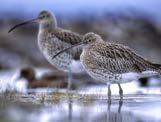
10 Confused hare – a flightless bird? (4)
11 Young newt (3)
12 RSPB Insh Marshes is on the floodplain of which river? (4)
16 On this island, home to an upside down lighthouse, the LIFE Raft project is saving seabirds from invasive species (see p76) (7)
17 One of the RSPB’s five nature reserves in the Dearne Valley (3,4)
18 Barnacle, Brent and Pink-footed are all types of (5)
19 A large sea duck whose call is reminiscent of comedian Frankie Howerd (5)
20 This brown and white martin visits the UK in summer (4)
21 Glaucous, Iceland and Audouin’s are species of what? (4)
If you enjoyed the crossword, please let us know (contact details p3)
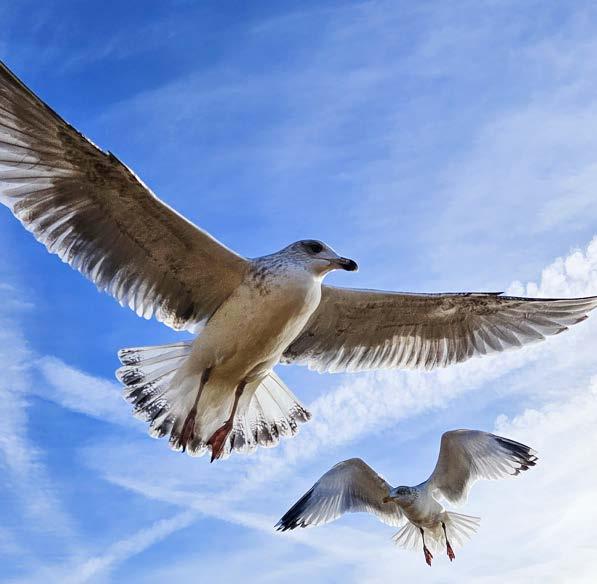
Star photo
Herring Gulls
This picture was taken on Brighton Pier. I managed to get a close shot as they were right above my head!
Maria Brewer
Send your wildlife photos to The RSPB Magazine. See page 3 for details
rspbshop.co.uk
RSPB Shop bundle worth £250!
Our star amateur photo wins £250 to spend on anything at the RSPB Shop! From wildlife garden ideas to homewares, books and even chocolate, everything is produced in the most sustainable and nature-friendly way possible, and proceeds go directly towards wildlife conservation. So treat yourself or a loved one, safe in the knowledge that you’re supporting both wildlife and sustainable, ethical businesses.







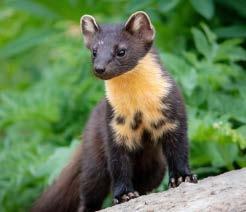
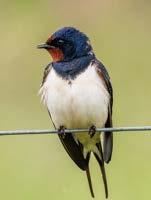
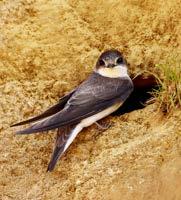
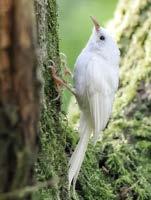
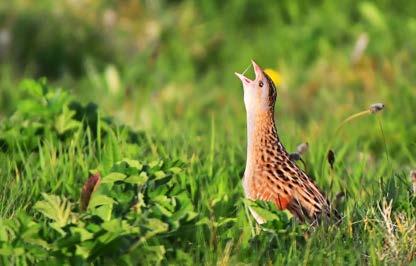
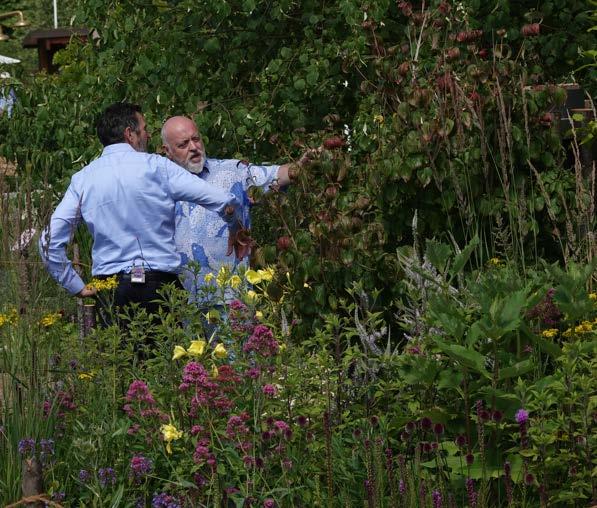
Gardening for wildlife? Share your achievements with adrian.thomas@rspb.org.uk
Adrian Thomas attended the launch of the RSPB/RHS Swift Garden at the Hampton Court Flower Show alongside Swift enthusiast Bill Bailey
Birds have been an important part of Bill Bailey’s life since childhood, and one bird has always held a particular fascination – the Swift.
So, it seemed a natural fit when Bill agreed to help launch a special RSPB/ RHS feature garden at this year’s RHS Hampton Court Flower Show, one that would celebrate Swifts, draw attention to their plight, and inspire as many people as possible to aid their recovery.
But how do you create a garden for Swifts? After all, their lives are spent in the open skies, not pecking in lawns.
That was the creative challenge facing garden designer Lilly Gomm and
horticulturalist Coralie Thomas. They had just six months to pull something out of the bag when most show gardens take well over a year!
There were two key themes they had to draw together. One is the fact that Swifts nest in holes in buildings, so the garden featured a range of what Lilly called ‘fragments’, demonstrating a range of Swift bricks and boxes. Interpretation helped ensure that visitors understood that, in reality, these need to be elevated five metres or more.
The second was that the actual garden element is important, too, showing how creating habitats for
garden birds and other wildlife can also help Swifts. After all, their aerial diet has its origins down at ground level.
Lilly and Coralie’s design also nodded to the range of habitats and locations that Swifts pass over on their astonishing migration, using over 1,600 plants to create a colourful but natural space.
With no hard landscaping and all plants grown peat- and pesticide-free, the garden had as little environmental footprint as possible. After the show, the plants were relocated just a few miles down the road where the charity Balance manages a community garden for adults with disabilities.

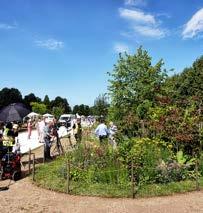

I grabbed some time with Bill to discover more about his Swift passion. “Their arrival and departure reminds us of the rhythm of nature,” he said. “When I see them, I think that all is well, despite the turmoil in this world. Oh, and of course they are beautifully aerodynamic – it makes them wonderful to draw.”
The garden allowed Bill to share the sobering message of the decline of the Swift. “But it also reminds us of the simple things we can all do that will collectively make a difference,” he enthused.
This message reached thousands of visitors, plus BBC Gardeners’ World, national newspapers, magazines and podcasts. Our thanks to the RHS for the chance to collaborate and to Henry Kenner at Action for Swifts who supplied the boxes and put in an incredible shift at the show. It was a wonderful way of helping put Swifts centre-stage.


1
The adage of ‘right plant, right place’ ran throughout the garden. Mediterranean plants occupied the sunniest, driest aspects; bright perennials filled sunny spots on richer soils, and shade-loving plants enjoyed the space under the trees. In the right places, plants are happy, meaning less work for you.
2 Don’t be afraid of shade in a garden. Yes, many insects like it tropical when they are flying about looking for nectar and pollen, but their caterpillars or larvae often like cover. And in hot weather, the shade is what you are likely to make a beeline for, too!
3 Fill your space with plants. All that green is so restful on the eye, and plants thrive when they are together in communities.
1. The Swift Garden formed a verdant, life-filled oasis among the parched Hampton Court turf 2. Here, Bill Bailey joins the garden’s creators: Lilly Gomm (right) and Coralie Thomas
3. The garden featured a secluded little pond tucked among the rich planting, adding to the variety of habitats
4. The evocative Swift sculptures that adorned the garden were created from bindweed and Akebia stems by artist Chatu Madhvani
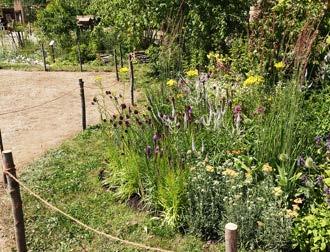
Lilly and Coralie created beautiful borders in the Swift Garden, mainly using herbaceous perennials – plants that come back year after year, but whose top growth dies down for the winter. Many of these plants bulk up and spread over time, making it a cheap and time-saving way to garden.
The simplest way to set out a perennial border is to split the bed into blocks, growing one type of perennial
A Swift box, such as the RSPB model shown top right, needs to be installed on a wall, ideally under the eaves, at least 5 metres up. It needs a clear flight line in and should face between north-west and north-east. Additional boxes can be added one metre apart.
Retrofitted ‘integrated’ nesting bricks (bottom right) can be included by housing developers during construction. In the RSPB’s flagship partnership with Barratt Redrow, thousands of boxes are being incorporated nationwide.
When the Swifts return next summer, record them on the RSPB SwiftMapper, swiftmapper.org.uk
within each. This creates visual impact, and you know exactly what should – and shouldn’t – be growing in each.
Because perennial plants have wellestablished root systems, they often require little watering, if any. Choosing plants with known wildlife value, such as catmints, globe thistles, Michaelmas daisies, scabiouses and heleniums, will transform your flowerbeds into real nature hotspots.
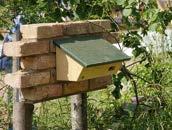

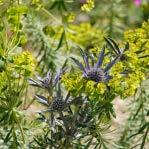
The Swift Garden featured an area of dry planting where Lilly and Coralie combined these two plants to eyecatching effect.
Eryngiums
There are several species of Eryngium – commonly called seaholly – you can grow in UK gardens, most with attractively bluish spiky leaves and flowerheads.
Most are excellent for pollinators.
They include the native Sea-holly Eryngium maritinum, found in sand dunes, but the Swift Garden featured Eryngium bourgatii from southern Europe (pictured above).
Almost all Eryngiums love freedraining soil and lots of sun.
Euphorbias – commonly called spurge – form a very large family, with several species native to the UK.
The flowers are shaped like a cup containing the male and female parts. They are often acid green.
They include the Wood Spurge Euphorbia amygdaloides, which is great for shady areas, but avoid the invasive cultivar called robbiae
For wetter areas, try the European species Marsh Spurge Euphorbia palustris, enjoyed by pollinators.
Handle spurges using gloves, long sleeves and goggles, as the sap can cause skin and eye irritation.
When I visited the Swift Garden, I was astonished to see the flowerbeds already bobbing with bumblebees and butterflies, despite having been in place only a few days. There were Gatekeeper and Marbled White butterflies, and several of this little butterfly (pictured right), the Essex Skipper.
There are eight species of skipper in the UK – only the Dingy is found in Northern Ireland. In Great Britain, only the Large, Small and Essex are regular in gardens, and only if you have meadowy areas. They are small, golden butterflies that sometimes hold their four triangular wings open like the pages of a book. The Large has the widest distribution, extending north into southern Scotland.
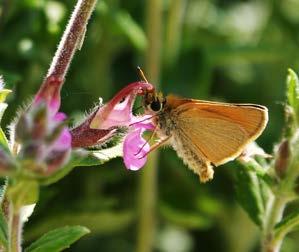
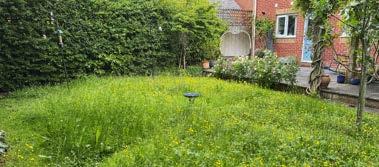
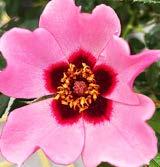
When we moved to our house in 2008, the tennis-court sized garden had a monochrome grass lawn and lowmaintenance evergreens. It was sterile and silent, with not a bird in sight. So, we set to work. We replaced the solid wall of leylandii down one side with a mixed hedge of Hawthorn, Field Maple and Hornbeam. For year-round colour we added roses, hydrangeas, fuchsias, periwinkles, lavenders and many more. In shady areas we planted Stinking Iris, Nettle and hellebores. We replaced the lawn with a wildflower mix, and it is now a wildlife-rich haven. We allowed Ivy to climb the house. Finally, this being Somerset, we added an apple tree and, as a nod to the changing climate, an Olive.
It took a while. But the garden is now full of birds year round. There is a constant late-summer flow of Blue, Great, Coal and Long-tailed Tits; autumn brings Goldfinches, Chaffinches and a steadily growing number of visiting Greenfinches. Blackcaps visit in summer, Starlings probe the lawn in winter, and Siskins pass through in early spring – last year I ringed 216 in just over two weeks.
Tawny Owls hoot at night, pipistrelle bats emerge from the bat box each summer evening, and a Hedgehog wanders in and out of the garden through the hole in the fence.
A host of bumblebees flit among the lavender and Red Admirals hover over the buddleia.
Dr Alison Morgan
Buy fabulous roses in the new Power to Pollinators range from the RSPB and Harkness Roses, with £5 from each sale going to the RSPB’s latest conservation work. The star of the collection is called RazzleBEEdazzle (roses.co.uk/product/531259/ rose-rspb-razzlebeedazzle), but there are other roses to choose from, too. Go to roses.co.uk/rspb

Questions answered by India James and Molly Brown, RSPB Wildlife team Ask us about wildlife at YourQuestions@rspb.org.uk

Why
Sophie Johnson
One study found that Redwings (pictured) prefer Holly and Hawthorn berries, while another highlighted the importance of Rowan berries early in the winter, and whitebeam in some areas. Redwings have also been shown to detect fruit using ultraviolet vision. The waxy coating of some berries reflects UV light,
and Redwings have shown a preference for these. Other factors, such as the timing of the berries or their size, can influence which are chosen. Some berries, such as Holly, may be more difficult for the birds to take earlier in the year and so might be left until they are riper. Learn how to paint a Redwing on p12.
Compost heaps are a great way to turn waste material into rich compost to put back into your garden and help support your local woodlice, worms and toads. Make a square structure from slatted wood (you can use upcycled wood or wooden pallets made from sustainable timber), and ensure one side is removable so you can access the compost when it’s ready. Start filling it with a mix of
green materials (grass clippings, weeds, and uncooked vegetable peelings) and brown materials (sticks, dried grass, wood chips, shredded paper and cardboard). Shred material where you can to help it break down more quickly, and water the heap in dry weather to keep it moist. Over time, your compost will turn dark brown and crumbly, that’s when you know it’s ready to use.

Have you ever wondered how plants and fungi communicate?
The ‘wood wide web’ refers to the underground network of certain fungi and plant/tree roots. This incredible system allows resource sharing and exchange and even communication. For example, a fungus attached to a plant through this network can receive carbon from the plant, and in return the plant can get nutrients and improved access to water. Remarkably, plants that are being chemical warnings through this network,



Dawn Taylor
This brilliant photo shows one of our winter visiting swans. The Whooper Swan is one of the lovely swan species we have in the UK, along with Bewick’s and Mute Swan. Although they may look quite similar, there are some defining features to help you identify a Whooper. It has a pale-yellow bill that forms a triangular shape on either side with a smaller black triangular tip. Whoopers are the largest of the swan species here, with a long neck they typically hold upright, and black legs. These majestic birds arrive in the UK for the colder months, journeying all the way from Iceland, so you may be lucky enough to see one if you’re visiting a wetland this winter.

I have seen a Hedgehog out during the day in my garden and heard about a new virus – is this the cause?
A Hedgehog out in broad daylight, especially in the cold winter months, can often be a sign of an injured or sick animal in need of help, but it’s not always cause for alarm. For example, pregnant or nursing females foraging for extra food, hungry youngsters, or Hedgehogs looking for a nest site may also be active during the day, particularly when the nights are short.
However, Hedgehogs do face a range of health issues and if one shows signs of illness, it’s wise to seek expert advice. A veterinary examination is needed to reach a diagnosis and guide any treatment, if required. The recently detected Hedgehog arterivirus has been linked to neurological disease outbreaks in Hedgehogs in care, but its occurence and impact on free-living Hedgehogs remains unclear.
Please report any sightings of sickness or death in Hedgehogs to gardenwildlife health.org to help monitor their health and learn more about the various disease conditions that may be affecting them.

These medium-sized ducks are found across the UK during the winter. The Wigeon is a dabbling duck, while the Pochard is a diving duck. Dabbling ducks feed near, or just under, the surface of the water. Diving ducks, on the other hand, are typically found in deeper water, where they dive down to search for food. These ID tips relate to adults in their winter plumage (males can look very different in eclipse plumage during the summer). Both ducks can be found in large flocks, outside of the breeding season. ID more ducks on page 14.

Wigeon
• Rounded head with steep forehead
Both male and females have a small, pale blue-grey bill with a black tip
• Males have a chestnut head and neck with yellow forehead, a pink breast, grey body and black tail
Females and juveniles are mottled reddish or grey-brown
Males display white wing patches in flight


• Males have bright red eyes, a chestnut head and neck, black breast and tail
• Females have a pale eye ring and line behind the eye and a dark patch below the eye
• Juveniles are similar to females
• Both males and females show a grey wing stripe in flight
Jules Cox (rspb-images.com). Illustrations: Mike Langman (rspb-images.com)
Crossword answers: Across 3. Harpy, 8. Rose, 9. Tern, 10. Reeds, 13. La rch, 14. Pygmy, 15. Fulmar, 17. Oyster, 18. Geltsdale, 22. Flood, 23. Nest, 24. Teal, 25. Snare Down 1. Birdlife, 2. Kestrel, 4. Arne, 5. Pied, 6. Speight, 7. Vineyard, 10. Rhea, 11. Eft, 12. Spey, 16. Rathlin, 17. Old Moor, 18. Goose, 19. Eider, 20. Sand, 21. Gull



























































































































WHATEVER your sleep problems, the dream of a good night’s sleep has now become a reality - thanks to a breakthrough invention - the Gx Suspension Pillow. All conventional pillows atten signi cantly during sleep - becoming less supportive and more uncomfortable as the night progresses. The result of this is disturbed and broken sleep, frustration and the fruitless search for a better pillow. That search is now over!




To stop the attening we’ve come up with a solution that’s so simple it’s ingenious. By the clever installation of ‘double X’ internal ties we have produced the world’s rst pillow to retain much more of its plumped shape all night long.
The ties work to pull the pillow in and up so that your head and neck are gently cradled and supported in softly sprung comfort. As well as having the revolutionary internal ties, the pillow shell is 100% cotton with our superb hypoallergenic Polycoz lling, and we have added a unique integral air vent to help keep you cool through the night.
Actor Rula Lenska had this to say:
It is rare that something advertised as unique and life changing turns out to be true!! I have a chronic back and neck situation and I can honestly say these pillows make a huge difference!! Comfortable…supportive…and positively magical for my neck!! Congratulations! Many, many thanks










As if all these bene ts were not enough, you can purchase the pillow with our 30-night comfort guarantee – total satisfaction or your money back*. Hundreds of thousands of delighted customers have already rediscovered the bene ts of a great night’s sleep, why not join them? Now available with 25% o for The RSPB Magazine readers, use code TRM14.





















comfort and support Integral air vent keeps you cool







Rare and precious wildlife living on islands is under threat; Jamie Wyver shares how the RSPB is working hard to restore natural balance
comparisons

See how the islands we work on compare in size and shape. While size and scale may change, all the island restoration projects the RSPB works on can make a huge difference to vulnerable populations of birds.
On five islands in the Indian Ocean, there is a striking little bird that would simply not exist without the efforts of the RSPB, working alongside local conservationists. This black and white bird, smaller than a Starling, is one of the rarest birds in the world. Thanks to RSPB supporters, the Seychelles Magpie Robin avoided extinction, and its numbers are now rising.
Isolated from the mainland, island wildlife can evolve in interesting directions. Over time, birds adapt to the island’s specific climate, habitat conditions, and types of foods, and on islands these adaptations are easy to observe when compared to related birds on other islands. Indeed, our understanding of evolution and natural selection was shaped by Charles Darwin observing Galápagos Islands finches and Alfred Russel Wallace’s studies of birds of paradise across the isles of the Malay Archipelago.
On islands, birds may become smaller or larger than their continental counterparts. Where there were no ground predators, some evolved into flightless birds such as the now extinct Dodo and Rodrigues Solitaire. That isolation and uniqueness makes extinctions such as these more likely. Since the loss of the Dodo, around 90% of bird species becoming globally extinct have been those that lived on islands. Over half of the birds classified as Critically Endangered either breed, or spend their entire lives, on islands.
An invasive issue
Why are island-dwelling birds so vulnerable to extinction? Small populations of birds, which have evolved to withstand loss to native – or no – predators can quickly succumb to predation by animals accidentally or deliberately introduced to their island homes by people. These new additions can include birds of prey, insects or reptiles, but often the greatest damage to island ecosystems is caused by mammals. Historically, we wouldn’t expect to see carnivorous land mammals on small, remote islands. Birds, insects and reptiles can easily colonise these places through flight, swimming, or perhaps eggs or young hitching a ride on floating vegetation. So for thousands of years, birds and other wildlife evolving on remote islands have done so without the pressure of predation by cats, dogs, pigs, rodents, Stoats and other mammals that might otherwise pose a threat.
But as humans began to traverse the planet more, the mice and rats stowed away on the ships came, too. Cats and dogs quickly followed, often brought in to deal with the problems the rodents were causing. Flightless birds, and those naive to the dangers posed by people and their accompanying animals, proved
easy to catch. There were other new threats too, including habitat destruction, introduced diseases, capture for the pet trade and hunting.
And so the extinctions began. Since the 1600s, Hawaii has lost 23 bird species; New Zealand 15; and closer to home, the Great Auk’s last stand in the UK was on St Kilda before it was eventually lost worldwide from Eldey Island, Iceland. Three species were lost in Seychelles, with others at risk.
The Seychelles Magpie Robin was once found on numerous islands across the Seychelles inner islands. However, when its native forests were felled and replaced with plantations, it began to disappear. The arrival of cats and rats further pushed the bird towards the brink of global extinction. Despite attempts to make more of the islands safe, along with reintroductions, populations failed to recover. By the late 1970s, there were no more than 20 Seychelles Magpie Robins on a single island.
The RSPB began funding and managing the bird’s conservation programme in 1990, and in 1998 helped set up Seychelles’ BirdLife Partner, now Nature Seychelles, which took over management of the programme. “Back then, the Seychelles Magpie Robin was teetering on the edge of extinction,” reflects Dr Nirmal Shah, Nature Seychelles’ Chief Executive.
Previous: Manx
Shearwaters largely rely on remote UK islands for breeding
1. Giant tortoises may have an important future role in restoring Seychelles forest ecosystems
2. The Seychelles Magpie Robin was close to extinction
3. Cousin Island
Special Reserve is one of five islands that is now home to the Seychelles Magpie Robin
The first step was to start removing cats and rats from the islands where the birds nested. Research suggested that temporarily providing extra food for the robins could improve their breeding success, so conservationists supplied cockroaches, boiled rice, shredded coconut and fish! This worked, but could only be a short-term solution. The birds’ habitat needed to be restored, and the team undertook extensive removal of alien plants, such as coconut trees, and planted thousands of indigenous trees.
“The programme marked a pivotal moment in modern conservation efforts in Seychelles, as it was the very first initiative aimed at recovering any species here, as well as giving us the opportunity to raise more funding, especially from the Global Environment Facility,” says Nirmal. “Since then we have also conducted research on the Seychelles Paradise Flycatcher, the Critically Endangered Seychelles Scops Owl, the Seychelles Fody, and continued our efforts with the Seychelles Warbler.”
In 2005, the Seychelles Magpie Robin was downlisted from Critically Endangered to Endangered on the IUCN Red List. And, in 2023,
‘Over half of the birds classified as Critically Endangered either breed or spend their lives on islands’


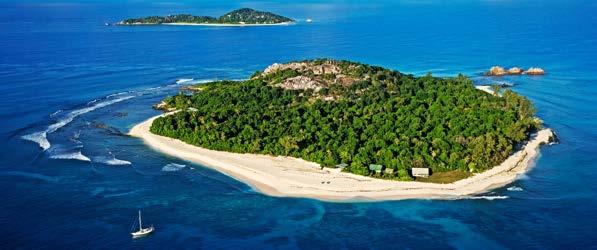

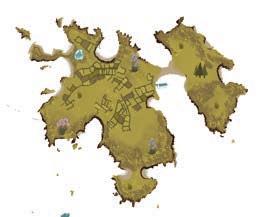
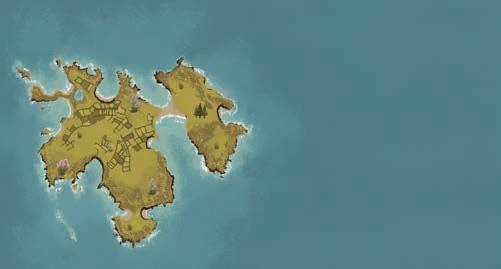
Pre restoration project 0 pairs
Post restoration project 100 pairs
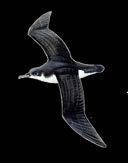
Pre restoration project 0 pairs
Post restoration project 154 pairs
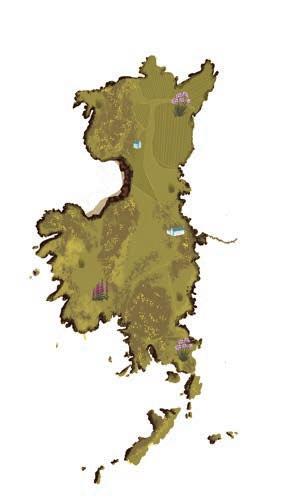





conservationists estimated that the population of Seychelles Magpie Robins was around 500–600. Recently, the role of giant tortoises has been better understood. Once common on the islands, the tortoises disturbed the forest floor as they moved around, exposing insects for the robins. Helping the endangered tortoises to recover may give the robins another boost.
However, there is a long-term threat that could affect all the islands on which the Seychelles Magpie Robin remains. Sea level rise, driven by climate change, risks eroding much of the robin’s suitable lowland forest island habitat. In March 2025, a United Nations Conference on Trade and Development report identified Seychelles as the African nation most at risk from climate change.
Restoring far-flung places
Beyond Seychelles, the RSPB also works with local conservationists on several islands that form part of the UK Overseas Territories. These include St Helena, Tristan da Cunha, and Turks and Caicos.
Island restoration projects are not just about the removal of predators, as shown in the case of the Seychelles Magpie Robin. The damage done to habitats through clearing of forests for crops, or the introduction of invasive plant species, also needs to be reversed. On St Helena, in the South Atlantic Ocean, there are two projects that demonstrate this.
The St Helena Plover (or Wirebird, so-called because of its thin legs) is only found on the island of St Helena. Thanks to efforts to remove invasive predators such as cats, Wirebird numbers increased from just 208 in 2006 to around 615 now. Work continues, led by the St Helena National Trust, to improve the pastures where the Wirebirds breed and feed, a project funded by the UK Government’s Darwin Plus scheme. Invasive plants have changed the structure of these pastures, so the project is trialling ways to remove them and support local people to begin sustainable grazing schemes, which helps both the community and the wildlife.
Meanwhile, in the island’s cloud forest, the RSPB and partners – funded by the UK Government’s

Foreign, Commonwealth and Development Office – have removed invasive plant species and planted over 40,000 native plants to help restore the forests. This planting also aids the forests’ ability to hold water, slowly releasing it to communities downhill.
Bringing lessons home
The skills involved in island conservation, such as removal of invasive species, translocations of rare wildlife and building capacity in local communities are transferrable between projects and locations. Inspired (and often taught) by global island restoration specialists such as Biz Bell from New Zealand’s Wildlife Management International Limited (WMIL) and Professor Carl Jones, the Scientific Director of the Mauritius Wildlife Foundation, RSPB teams share a practical, can-do approach.
“This work is driven by detailed data and planning, but relies on good basic fieldwork skills from staff and volunteers,” explains Dr Karen Varnham, Senior Specialist in the UK Species Recovery Programme. “The team culture is to remain upbeat about chances of success – what we call the ‘eradication mindset’.”
This ethos also applies to RSPB teams working on restoring islands closer to home. Seabirds aren’t restricted to living on small islands in the same way as the Seychelles Magpie Robin, but they are often dependent on them as safe havens for breeding. Most (80%) of the planet’s Manx Shearwaters nest in burrows on islands off the west coast of the UK, so we have a significant responsibility for their conservation. The islands include RSPB Ramsey Island, off the coast of Wales, Lundy in the Bristol Channel, St Agnes and Gugh in the Isles of Scilly, and the Shiants in the Outer Hebrides. On all of these islands, the arrival of rats meant that the shearwater colonies had either disappeared or significantly declined.
Brown Rats arrived on Ramsey Island in the late 1800s and decimated bird populations. Puffins, and probably Storm Petrels, were completely lost from the island and only 850 Manx Shearwater pairs remained. With the help of WMIL, the RSPB made the island rat-free by 2000. Storm Petrels returned in 2008 and there is a small but stable population of 10–15 pairs.
Lundy island
Devon, England


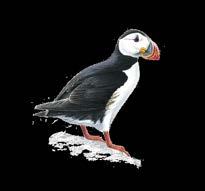
7,000 birds
Post restoration project
40,000 birds
At the last Manx Shearwater census in 2022, the population was 6,225 pairs.
While Ramsey is only occupied by the small RSPB team, St Agnes and Gugh have around 85 inhabitants. So here, the removal of rats required a community effort. Rats first arrived from shipwrecks and, as their numbers grew, seabird numbers declined. Breeding Manx Shearwaters were completely lost, along with England’s only regular breeding colony of Storm Petrels. Between 1983 and 2006 the overall seabird population on the Isles of Scilly fell by 25%. The Isles of Scilly Seabird Recovery Project, led by the RSPB, brought together communities to help bring back the lost seabirds. Local people played a key role, helping bait the islands and reducing alternative food sources available to the rats. St Agnes and Gugh were declared rat-free in 2016. In 2024, there were 154 Manx Shearwater pairs and over 100 Storm Petrel pairs.
Lundy Island once held an incredible 80,000 seabirds, but by 2000 only 7,000 remained. So in 2002, working with the landowner the National Trust, the land manager the Landmark Trust, Natural England and WMIL, the RSPB helped to make the island rat-free. The island now has one of the largest seabird colonies in England. There are more than 150 pairs of Storm Petrels, and 95% of England’s breeding Manx Shearwaters nest there.
The Shiant Isles Recovery Project, run by the RSPB, NatureScot and the Nicolson family (the island owners), brought in WMIL and other experts to eradicate Black Rats so the seabird colonies could recover. The Shiants were declared rat-free in 2018 and breeding Storm Petrels returned. The RSPB and NatureScot are also currently working with Orkney Islands Council on the Orkney Native Wildlife Project – funded by National Lottery Heritage Fund.


Previously a haven for endangered ground-nesting birds such as Curlew and Hen Harrier, as well as seabirds and the endemic Orkney Vole, the wildlife of this archipelago came under threat from Stoats in 2010. Since the project launched in 2019, Orkney Vole numbers are up 200% and successful Hen Harrier nesting attempts are up from 36% to 82%.
Ramsey Island Gin Created by St Davids Distillery, Ramsey Island Gin includes botanicals collected from the island by the RSPB Wardens as part of their habitat conservation. Sales of the gin help to raise money for work on the island. tinyurl.com/rspbramsey
You can take responsibility for your own biosecurity by following these important steps before visiting your island destination:
Check your baggage for signs of stowaways and avoid storing it where invasive predators can access prior to travel
If you operate a vessel travelling to an island, check regularly for signs of stowaways
Pack food on the day you travel and store it in rodent-proof containers
If you see a stowaway on board
your transport, do not land at your island destination. Also do not push it overboard (most mammals are good swimmers)
Report sightings of invasive predators to the island owner or via the website below
Dispose of your rubbish and waste materials responsibly
Find out more at biosecurityforlife.org.uk
Rathlin Island is home to Northern Ireland’s biggest seabird colony, with the largest population of breeding Guillemots in the UK and Ireland. Non-native Brown Rats and Ferrets have had devastating impacts on the seabirds there; including a decline in priority species such as the Puffin. The RSPB’s LIFE Raft project in Northern Ireland, run alongside the Rathlin Development and Community Association, is aiming for a world-first Ferret eradication. Meanwhile the team are working to remove the Brown Rats. As well as help from the community, specially trained dogs such as Woody (pictured) are on hand to check for invasive predators.
Our work isn’t done Biosecurity measures – such as those shown left – are crucial to prevent invasive predators on these islands. From 2018 to 2023, the RSPB, the National Trust and the National Trust for Scotland joined forces for the Biosecurity for LIFE project, Save Our Seabirds. This aimed to protect the UK’s most important seabird islands against the threat of invasive non-native mammalian predators. As a result, island owners, managers and communities on 95% of these islands are now equipped to detect and respond to invasive predators. This work continues through separate country projects as biosecurity is needed in perpetuity. With your support, the RSPB is helping reverse the decline of island bird and wildlife populations, giving species a greater chance of survival. Thank you.

Jamie Wyver is Editor of The RSPB Magazine. He has an MSc in Conservation Science, a course based at Imperial College London and run in conjunction with ZSL and other organisations.
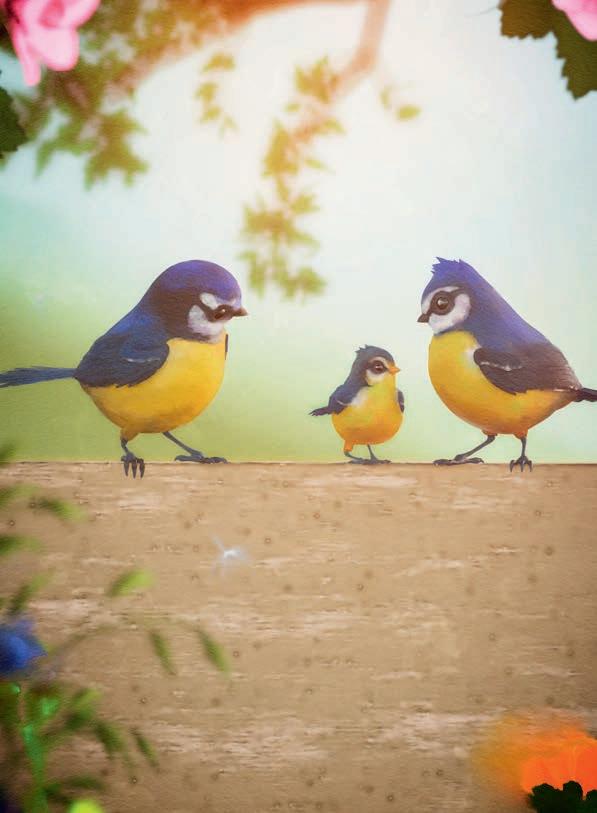
At the RSPB we know our connection to nature is irreplaceable. We must nurture and protect it, because without it we are lost.
That’s why we’re working tirelessly to tackle the biggest threats facing our world, so one day we can truly thrive together.
A gift in your Will to the RSPB is one of the most powerful ways you can support this mission for generations to come.
Request your RSPB Gifts in Wills guide at rspb.org.uk/legacy or call one of our Legacy Advisers on 01767 669700
David Lindo

David Lindo is The Urban Birder and founder of The Urban Birder World, theurbanbirder world.com
Every October, Black History Month commemorates the achievements of prominent figures in the black community. Originating in the United States in 1970, Black History Month in the UK has become a celebration of the successes of British black people since 1987. Since then, many people have been lauded: famous cultural visionaries, athletes, politicians and activists, as well as lesser-known, though equally important, business figures and community heroes. These people have all been instrumental in quelling racism and normalising the notion that black people and people of colour have a massive role to play in society.
This is all well and good, but my focus has always been the world of conservation. Who are the black leaders in this field? When I looked up famous black conservationists in the UK, my research yielded a disappointing result: a big fat zero. I could not find one name. Not one. There are a few notable figures from the States, including Moses Williams (1777–1827), who was America’s first black ornithologist. Born into slavery, he later worked in a museum that housed bird specimens and learned the art of taxidermy. We have no such stories.
I have been a birder for several decades, and when I started venturing out into the field, it was during the height of in-your-face racism in the UK. I could understand then why I did not see another black face out birding. It is now 2025 and, if anything, I am out even more, birding the length and breadth of the country, and I still don’t see any black faces. Indeed, over the last 10
‘Despite the barriers, there are some great people out there doing fantastic engagement work, such as Flock Together’
years, I have seen or met just four black birders in the field.
I mentioned in a previous column that I thought that the lack of birders of colour was down to how nature was being ‘sold’ to us by the media, predominantly through the lens of white, middle-class, middle-aged men. I also mentioned that education played a huge part, too. Kids of all colours and creeds (particularly urban kids) are not exposed to nature at an early age. They grow up not seeing anyone like them acting as mentors in prominent positions within the conservation world. So, they are instantly discouraged from participating. I, too, am dispirited by this. Of course, there have been people of colour on programmes such as Springwatch, including me. But there certainly isn’t enough representation.
I also think that the organisers of Black History Month should stop stereotyping black success as being mainly the domain of the categories I mentioned previously and more actively highlight people making waves in less obvious sectors, such as the conservation world. This may have a stronger impact in galvanising black people than the work of any of the nongovernmental organisations – not to underplay the good work that these organisations are already undertaking.
Despite the barriers, there are some great people out there doing fantastic engagement work, perhaps the best-known being Flock Together founded by RSPB Ambassadors Nadeem Perera and Ollie Olanipekun. If I am honest, I am struggling to name a prominent British black conservationist other than Hamza Yassin. However, there are young, up-andcoming conservationists such as Kabir Kaul, the London-based naturalist who has been awarded for his outstanding work; he’s an exemplary young man. Lira Valencia is another. She is a passionate, straight-talking and very influential conservationist with a huge following on Instagram. In my opinion, if conservation NGOs want to honour Black History Month, they should start by honouring the people who are already carrying the flag.
To advertise here, please contact Kirsty Hibbert, 0117 476 7383, kirsty.hibbert@ourmedia.co.uk
Port Isaac Cottage for 6 in bygone fishing hamlet on N coast. Washer-dryer, dishwasher, PC + wireless broadband, full CH. Gardens. Pets welcome. £350 (winter) – £1070 pw. Tel: 01208 880106
Nr Penzance 2 remote cottages on Penwith moors. Slps 2-4. Available all year. See for miles across fields & heathland down to the sea. Nr Marazion Marsh & Hayle Estuary. Tel: 01736 363677. www.dingdongcottages.co.uk

Stay 15mins walk from RSPB Marazion Marsh at our historic coaching inn with 11 super-comfy ensuite rooms & award-winning restaurant. Sea-view rooms available, just metres from the tidal island of St Michael’s Mount. 01736 710334. marazionhotel.co.uk
Arnside, s/c flat on promenade slps 4, estuary views, Leighton Moss 15 mins. 01524 761749. www.inglewoodcourt.co.uk
Lake District, Ravenglass Enchanting coastal cottage, sleeps 3, panoramic sea/estuary views. Near Drigg, Duddon, St Bees, Hawk & Owl Centre, Eskdale, Wasdale, Scafell. www.rosycot.co.uk 01946 723413
Otters, owls, dipper, kingfisher Separate annexe, slps 2, near river with 34 acres. On Devon/Cornwall border 01566 784196. www.coombemillshippen.co.uk
Glorious North Devon. Only 9 cosy caravans on peaceful farm. Wonderful walks in woods & meadows. Easy reach sea, moors & lovely days out. £125-£395pw. Discount couples. Nice pets welcome. 01769 540366 www.snapdown.co.uk
Exmoor, nr Dulverton. Very comfy cottage in tranquil secret setting, fine views, direct access ancient woodland nature reserve (SSSI), moor & river. Ideal location for birdwatching and walking. Sleeps 2-4. Tel: 07974 770761. www.mounseyend.co.uk
Nr. Weymouth. Comfortable VE4★ cottage slps 4. Nr Jurassic coast & bird reserves. 01305 760120. www.stonebank-chickerell.co.uk
POOLE HARBOUR shoreline cottage sleeps 4. Stunning views. Close Poole Quay. Prices from £350pw–£1040pw. www.sandbanksview.co.uk Simon 07860 866183
Slimbridge. Tudor Arms. Real ale & good food pub with rooms. Close to WWT. enquiries@thetudorarms.co.uk Tel: 01453 890 306. www.thetudorarms.co.uk
Hereford. Farmhouse B&B on banks of River Wye. 07974 952884 for brochure or www.sinkgreenfarm.co.uk
DUNGENESS: comfortable cottage ideal for RSPB. 2 en suite double bedrooms. Openplan kitchen/dining, large lounge, wood fire, Wi-Fi. Sightings of rare birds. RSPB site next door. www.wiwurri-dungeness.co.uk or annpatriciamcferran@gmail.com
Nr Dungeness/Rye, B&B, All Ensuite, RSPB 3 night or more 10% discount. 01797 362381. www.broadacrehotel.co.uk
Holiday cottages . Between Boston & Skegness. Ideal for RSPB Freiston Shore, Frampton Marsh & Gibraltar Point. For brochure: crewyardholidaycottages.co.uk 01205 871389
Old Willow Barn Nr. Boston, Lincolnshire

Weybourne North Coast next to Cley etc, comfortable 5-bedroom house, 10 bed, slps 14, large dining, living room, parking, garden, Wi-Fi etc. Ring/text 07966133463 for details
WEYBOURNE Two self-catering holiday lets (sleep 4/5 and 6/7) within private nature reserve. Beach 250m. Bird list 251 species! Tel: 01263 588131 www.denmarkhousenorfolk.co.uk
Cromer. Coach House Studio. Delightful. Sleeps 2. Private courtyard. Large reception. Ideal for exploring N Norfolk, both east & west. Dogs welcome. www.coachhouse.studio
Wells-next-the-Sea. ‘The Snug’, a cosy hideaway for 2. Also 1 double room B&B 01328 710594. www.thesnuginwells.co.uk
Holme next the Sea. Comfortable bungalow near beach, sleeps up to 6. Convenient for Wild Ken Hill, RSPB at Titchwell & Snettisham, and 2 long distance paths. Dogs accepted. davidtuthill28@hotmail.com
Between Blakeney & Cley. S-C annexe slps 2. Garden area, birdsong and parking. Also B&B suite. 01263 740 840
Norfolk coast. Brancaster. Comfortable house slps 10. Reasonable. 07768 333373
Period cottage, N Norfolk 1 mile coast. Sleeps 2+2. Quiet village, large garden, private parking, Wi-Fi. 07850 989531. www.churchcottagelangham.co.uk
Salthouse, near Cley Lovely cottage. Slps 6, garden, parking, log stoves, Wi-Fi. All-year availability. 01256 381333. www.chalkhillbluecottages.co.uk
Thornham. Bungalow slps 6, dogs welcome. Sea/ marsh views, enclosed garden, ample parking. suehaines1087@outlook.com Tel: 01449 781145
Brancaster Staithe. S/c cottage, slps 2-7, Titchwell 3 mls, coastal path 200m, 01223 690335. www.seaaster.co.uk

Based on Bryher, visiting Tresco, St Martin’s & St Agnes

For more details contact: David Rosair, Island Ventures 01227 793501 www.islandventures.co.uk
Hunstanton Cosy 2 bed annexe sleeps 2/3, Great location for beaches RSPB Titchwell and Snettisham, Ken Hill and stunning coastal path. Parking. Open all year. 07432563331. Joannabostrom@hotmail.co.uk www.seahenge.co.uk
SNETTISHAM, 20 mins WALK from reserve! Quirky holiday home with Victorian railway carriage inside! 4 bdrms, Wi-Fi, woodstove, slps 2-8, big garden. www.the-patch.com, patchinquiries@aol.com
SHERINGHAM: Comfortable, convenient, flint fishermen’s cottage, close to beach, shops and amenities. Wi-Fi. Sleeps 2-5. 01223 834476. sue.hunting@ntlworld.com
BIRDER’S PARADISE NORTH NORFOLK. Snug, comfortable cottage sleeps 5. Views of Scolt Head Island, 13mins drive to RSPB Titchwell. Sarah: 07747 075340 or email sarahcynthiajohnson@gmail.com
Lindisfarne Reserve Cosy farm cottages 4. 1/2m shore or mainland slps 5. The Lookout, s/c studio slps 2. 01668 213533. www.fenham-le-moor.co.uk
Meare. Licensed 4 B&B close to the Moors & Wetland bird reserves. 01458 860449 www.mearemanor.co.uk
Shapwick. Take advantage of our location, staying in one of our unique luxury cottages. Easy access to Avalon Marshes, RSPB’s Ham Wall & other reserves. 07513 438623. info@wheelwrightscottages.com
Westhay. Farmhouse B&B 4 silver, 1/2 mile Avalon marshes, Shapwick Heath etc. 01458 860238. www.newhousefarmbandb.co.uk
B&B in Westleton, close to RSPB Minsmere Barn Cottage is in a quiet position in this pretty village, the 3 bedroom well equipped cottage is also available for self catering holidays during most months of the year. Sue Brett, 01728 648700 or 07970 968342 or www.westletonbandb.co.uk
Snape. Rose Tree Cottage. Short walk to Snape Maltings; Minsmere 7m; 2 bedroom, sleeps 4, excellent facilities, private garden. www.snape-cottage.com 07957 212118
www.suffolk-selfcatering.co.uk
1 mile, Mulleys Cottage, two B&B rooms en suite/one double self catering apartment. Quiet village spot. Beautiful country cottage. Two pubs close by. Walking distance to Minsmere. Tel: 01728 649036.





South of Chichester
07710 314251
Rural detached 2
b

honeysucklelodge.co.uk

Worcestershire
bedroom cottage, ensuite & wet room. Footpath to Medmerry RSPB Reserve. Full central heating.
Malvern Hills – cosy log cabin on outskirts of lovely village. 2 dble beds, all mod cons, dogs welcome. Private let. Please call Scott on 07768 340 645. www.simplyowners.net use property ID P27668
Yorkshire
1 mile from RSPB Bempton Cliffs
Newly-renovated, cosy cottage for up to 5+ Vegan-friendly & peaceful. 07974 690210 www.kittiwakecottagebempton.co.uk
Yorkshire Wolds & coast, RSPB Bempton
Stylish 4&5character cottages. Sleeps 2&4. Dog friendly. Short breaks. 01377 255639 www.churchfarmgarton.co.uk
Low Muffles Bridge, North York Moors. Cosy, quiet eco-cottage. Secluded valley by Rosedale. Sleeps 4-5. Owls, curlews, nightjars… 07747 495884 Search: airbnb low muffles bridge
Borders
Near Jedburgh. Modern guesthouse in peaceful setting beside Jed Water. Wide variety of birds on doorstep. Pets welcome by arrangement. Own riding stables. AA 01835 863279. www.ferniehirstmill.co.uk
Dumfries & Galloway
Ground floor flat for 2 in Glencaple village. Cosy & well-equipped. Close to RSPB, WWT reserves & Red Kite Trail. In winter, geese fly past your window twice a day – flocks of ducks & waders are seen in large numbers. In summer ospreys nest nearby. www.glencapleholiday.co.uk 01387 770348
Luce Bay. Comf trad seaside cottage. Sleeps 4 STB Dogs welcome. Mrs McMillan 01581 500233. www.lucebayholidaycottages.co.uk
Tree sparrows galore! Peaceful s/c cottages, wonderful views. Dumfries 5 miles. www.mcmurdoston.co.uk 01387 740200
Stylish, cosy, eco-friendly, new-build cottage with panoramic views across farmland, Solway Firth & the Lake District hills. Ideal location from which to watch migrating barnacle geese. Very close to RSPB Mersehead. 01556 504030. www.discoverscotland.net
Highland – Mainland

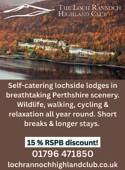
Nethybridge. High standard s/c cottage. Open all year, red squirrels and crests in the garden. Tel: 01479 821803 or email salmonpools@googlemail.com




593 cooperkc@protonmail.com www.airbnb.co.uk/h/Snowdonia-BirdsAndWalks

Isle of Mull Luxury 4 S/C just for adults. Abundance of birds & wildlife.
01688 317713
www.hideawaylodges.co.uk
www.Brodgarcottage.co.uk on RSPB Nature Reserve in the heart of Neolithic Orkney, Brodgar otters featured on Spring Watch. Slps 4

BIRD COTTAGE, sleeps
4. Fantastic birdlife, views & walking. Peace & quiet. Close to Kite centre & Elan Valley. Tel John 01483 200079. www.birdcottagewales.co.uk
Cottage for two with own nature reserve in quiet valley next to RSPB reserve, Elan Valley. A very special place for wildlife and birdwatchers. 01597 811169. www.wildlifecottagewales.co.uk

Cleddau Estuary. Isolated cott on shore, slps 4-8, with boat. brickyard-cottage.co or 01638 742344
Beautiful eco holiday cottages seek birders Wild flower meadows. Underfloor heating, log burner, EV charger. Strumble Head, Pembrokeshire www.stonescottages.co.uk 01348 891344
Contact
2TH Tel: 07730 004911
Relaxed tailor-made wildlife and culture holidays for small groups of up to 5 people

Uninterrupted views perfect for bird watching from both cottage and new lodge. www.denecottage-orkney.co.uk
Secluded cottage nr Breckon Beach. N.Yell slps 2+2. Run by a Shetland Nature tour guide & ex RSPB Warden. www.westerbrake.com
Secluded large comfortable beautifully restored off-grid barn, mid Wales. Sleeps 4/6. Ynys-Hir & Dyfi Osprey nearby. Surrounded by nature, wild walking & swimming. www.aimwild.co.uk. +44 (0) 7761 985732
Ystrad Meurig, Mid Wales

Dave Slater, Professional Birding guide in the beautiful Scottish Highlands. Tours and trips to suit all pockets, from day trips to all-inclusive holidays. Comfortable tour vehicle for up to four people. Call 07955336955 for details.
www.birdingecosse.co.uk
Spacious, modern bungalow, sleeps 2, adjacent Cors Caron nature reserve. Excellent birding, walking, touring. WTB No smokers/ pets. Brochure 01974 831471. www.maesgylfinir.co.uk
Dyfi Valley nr RSPB Ynys-Hir (Springwatch) & Dyfi Osprey project. S/c cottage, sleeps 5. Tel: 01654 702952. glangwyneddcottage@gmail.com
LUXURY COTTAGES Sleep 2–4 bordering Cors Caron NNR. Over 140 recorded bird species. www.cruglasfarmcottages.co.uk
Y Felinheli/Menai Straits. Close to Anglesey & Snowdonia. Modern cottage, garden, sleeps 2. WTB
07910 095991. trefeddyg.cymru
Llyn Peninsula near Abersoch Close to Wales Coast path. Static caravan off beaten track. Peaceful location, birds, walking, golf. Beach 5 mins. Dogs welcome. 07811 186969. margery.griffin@gmail.com
Abereiddy, Pembrokeshire. Beach, cliffs, coastpath 1/2 m. Traditional stone cottages on farm in peregrine territory, CH, one with log stove, 2 or 4 bedrooms, might suit 3-generation parties. Pets welcome. Brochure 01348 831482
PEMBROKESHIRE COAST NATIONAL PARK
Our warm and comfortable red sandstone cottages provide a spacious home from home, including biomass fuelled central heating, in lovely countryside two miles from the sea at Little Haven, with Skomer nearby. On your doorstep you’ll find the Rosemoor Nature Reserve, with its 5 acre lake, home to otter, wildfowl and kingfisher. Peregrine Falcons breed within view of our gardens. John M. and Jacqui Janssen, Rosemoor, Walwyn’s Castle, Haverfordwest Tel: 01437 781326 rosemoor@walwynscastle.com www.rosemoor.com (with lots of photographs)

Holiday cottages in Llanon between St Davids & Fishguard Pembs. Slps 2 or 4. Quiet location, lovely coastal walks. Close to RSPB Ramsey Island, Skomer. Details & prices: srsb.shaldonhouse@gmail.com Explore Alderney Autumn/spring migration stopover. Comfy CH cottage sleeps 7. Coast and country walks from the door. Pets welcome. Tel Bryony 07781 152205 3 bedroom house + garden sleeps 6 in perched Andalusian village near Gibraltar. Fantastic variety of local birds + spectacular spring & autumn migration. €630 pw. Information: jenkins.robin@orange.fr










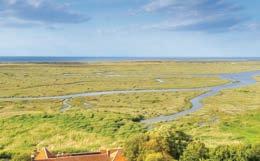

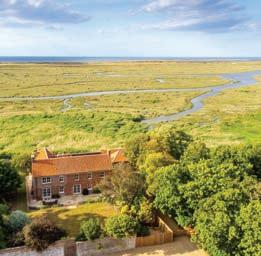











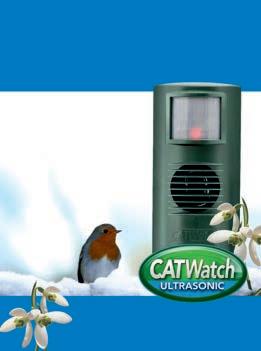







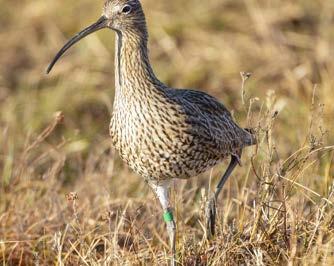
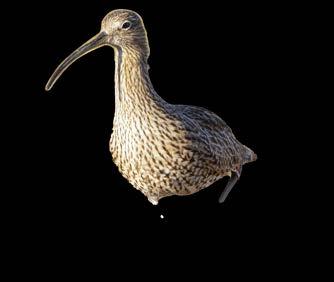
Protecting Curlews on the ground, one chick at a time, is what it takes to bring this species back from the edge. As well as helping farmers and landowners make changes to benefit Curlews, we’re putting in place the solutions that we’ve been carefully trialling for the last four years. Our Curlew appeal is now aiming to raise the money to make all this work possible into the future. If you’d like to know more, or are able to donate, please visit rspb.org.uk/curlews-call
Switching to a digital membership can bring your magazine to life in ways that print just can’t. From videos of RSPB experts and audio clips of bird calls, to brain-testing wildlife quizzes and interactive maps, we have loads to offer you when you make the switch.
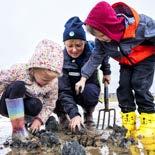
Not just for birdwatchers, the RSPB local groups are all about helping your local wildlife, discovering nature near you and connecting with like-minded people. You can drop in to group sessions and events for a chat; get hands on with conservation putting up nest boxes or litter picking; or even get involved as a leader, it’s entirely up to you! Read more on page 34 to find out what groups get up to, and find your nearest local group at rspb.org.uk/ local-groups
Choosing a digital membership also helps the RSPB save money, which can then be funnelled into vital conservation work. It also saves huge amounts of paper, which is good for the planet but also great for your storage space!
If you’d like to make the switch simply visit rspb.org.uk/go-paperless to opt in, or scan the QR code with your smartphone camera.
Scan for more info

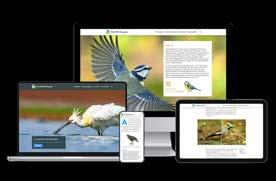
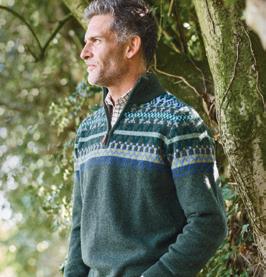




All of our nature jackets are made from rustle-free Nikwax® Analogy® Waterproof Fabric, which mimics the action of mammal fur to keep you dry, warm and comfortable in any weather.